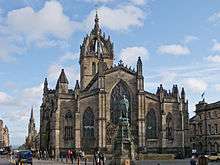List of former cathedrals in Great Britain
This is a list of former or once proposed cathedrals in Great Britain.
The term former cathedral in this list includes any Christian[1] church (building) in Great Britain which has been the seat of a bishop,[2] but is not so any longer. The status of a cathedral, for the purpose of this list, does not depend on whether the church concerned is known to have had a formal "throne" (or cathedra) nor whether a formal territory or diocese was attached to the church. Before the development of dioceses, which began earlier in England than in Scotland and Wales, "[s]uch bishops as there were either lived in monasteries or were 'wandering bishops'".[3] This list therefore includes early "bishop's churches" (a "proto-cathedral" is similar).
A former cathedral may be the building that lost its cathedral status or its site, whether now vacant or not. The loss of status may be because that bishopric is extinct, or was relocated. Sometimes a new cathedral was built near an older one, with the older building then used for other purposes, or demolished. Such a building or site counts as a former cathedral. Where a cathedral is modified or rebuilt on substantially the same site in a series of developments over time, the earlier versions are not counted here as former cathedrals (except for the unique case of London's "Old St Paul's").
A former pro-cathedral is a church or former church (or site of a former church) which was once a temporary cathedral officially performing that role until its expected replacement by an intended permanent cathedral took place, usually by completion of a new cathedral built for that purpose.
A once proposed cathedral is a church which, on some past occasion, was proposed (usually by a church or civil authority) as a future cathedral, but for some reason that particular proposal failed. In some cases, a later proposal succeeded and the church then became the seat of a bishop (but the church concerned will still be listed here for record purposes because of the earlier (failed) proposal).
England
References are to the English church's current use or its use prior to deconsecration.
Cathedrals founded before 1066
survivors becoming Church of England at the Reformation
| Location | Image | Name | Dates | Notes | Coordinates |
|---|---|---|---|---|---|
| Bradwell-on-Sea, Essex | 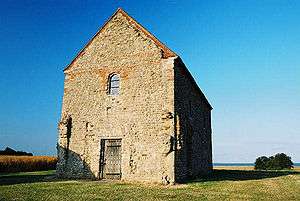
|
Chapel of St Peter-on-the-Wall | 654 –664 | After a mission to the East Saxons from London by St Mellitus failed in c. 616, St Cedd was sent from Northumbria in 653 (consecrated a bishop in 654).[4] His chosen site was the former Roman fort of Othona, near Bradwell. A stone cathedral[5][6] was built, of Roman materials, but Cedd died in 664. A third mission in c. 675, by St Erkenwald from London (which became the see for Essex) succeeded. After centuries as a chapel-of-ease, then used as a barn, during which time it lost its original west porch and eastern (chancel) apse,[7] it was restored and reconsecrated in 1920. It has been the chapel of the Othona Community since 1946.[8] Built on the edge of the Roman foundations, across a wall rather than centrally, it has been suggested that it may not have been the only church built here, nor the main one. | 51°44′07″N 0°56′24″E |
| Canterbury, Kent | 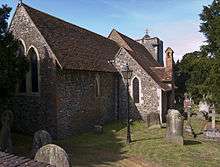 | St Martin's Church | 597–602 | This church has been used for the longest continuous time of any in Great Britain. Dedicated to St Martin by Queen Bertha of Kent, it dates from the Roman occupation of Britain (so before the early 5th century). Described as "old" when St Augustine landed in 596, it was his pro-cathedral[9] until a predecessor of the present Canterbury Cathedral was consecrated. St Martin's has been a parish church ever since.[10] | 51.277989°N 1.093825°E |
| Chester-le-Street, County Durham | 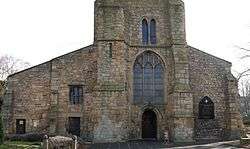 | Collegiate Church of St Mary and St Cuthbert | c. 883 – c. 995 | For a description and history of this church, on the site of a former cathedral, refer to St Mary and St Cuthbert, Chester-Le-Street. | 54.855944°N 1.571972°W |
| Crediton, Devon | 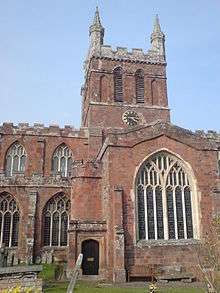 | Collegiate Church of the Holy Cross and the Mother of Him Who Hung Thereon | 909 –1050 | A purported charter of 739 by King AEthelheard of Wessex granted land here to Bishop Forthhere of Sherborne (who died c. 737, followed by Herewald)[11] for a monastery. A new see, for Devon and Cornwall, was created in the early 10th century out of the diocese of Sherborne. possibly first at Tawton, but certainly by 909 at Crediton. The (likely wooden) monastic cathedral of St Mary was replaced, after the see had been moved to Exeter in 1050, by a new collegiate church on the same site, with a new dedication from the 1230s. The college was dissolved in 1545, and the church was bought in 1547 by parishioners as their parish church. | 50°47′22.70″N 3°39′8.21″W |
| Dinuurrin, (Bodmin), Cornwall | 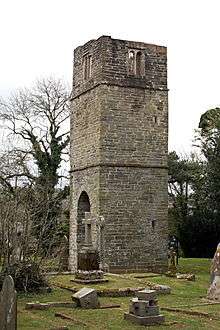 | Chapel of the Holy Rood | 9th C | Dinuurrin is a "lost" placename known only to us as the seat of a medieval Cornish bishop[12] named Kenstec. Sometime between the years 833 and 870 Kenstec declared his obedience to the Archbishop of Canterbury[13] at a "monasterium"[14] at Dinuurrin. There are good reasons[15] to believe that Dinuurrin was located om high ground at the northern edge of Bodmin. The Guild Chapel of the Holy Rood was built in such a place in the early 16th century, but fell into ruin soon after following the reformation - only the roofless shell of its tower (shown), now known as "Berry Tower", remains. However, the site is ancient and was of high status (with the chapel unusually enjoying rights of baptism and burial),[16] and it is thought likely that Bishop Kenstec's seat was here. Cemeteries surround the tower, with public access from Cross Lane. | 50.47525°N 4.71791°W |
| Dommoc, Suffolk | dedication unknown | c. 630 – c. 850 | Possibly translated from Soham, several locations have been suggested for the Anglo-Saxon see of East Anglia, founded by St Felix: notably (1) Dunwich, an important medieval town and port now under the sea, or (2) the old Roman fort of Walton now off the coast at Felixstowe. The latter may be the more likely, its placename being derived from Felix stowe (= Felix's holy place).[17] Two sets of co-ordinates are given: the first, very approximate, for (submerged) Dunwich; the second for the offshore masonry remains (visible only at exceptionally low tides) of Walton. The diocese was split c. 673, with the creation of an additional see at North Elmham, Norfolk. The list of Bishops of Dommoc continued until the Danish invasions of c. 850. | ||
| Dorchester on Thames, Oxfordshire | Abbey Church of St Peter & St Paul | 635 – c. 660 and c. 675 – 685/737 and c. 875 – 1072 | The first West Saxon see was founded here c. 635, translated to Winchester c. 660. It later became a Mercian bishopric for two periods: firstly, in c. 675 until merged into the Leicester diocese in c. 685,[18] (or c. 737);[19] secondly, in c. 875 when the sees of Leicester and Lindsey were transferred here for safety from Viking (Danish) incursions. That see was translated to Lincoln in 1072. The secular canons of 635-1140 were replaced by the Augustinian canons of Dorchester Abbey. After the dissolution in 1536 the chancel of the abbey church was bought in 1542 for £140 by Richard Beauforest, and on his death in 1555 it was left in his Will to the parish; the whole then became the parish church.[20] There are 11th-century traces, a (reconstructed) shrine of St Birinus, and a fine 14th-century Jesse window.[21] | 51°38′37″N 1°09′51″W | |
| Durham, County Durham |
|
The White Church (Alba Ecclesia) (almost certainly dedicated to St Cuthbert) | c. 998 – c. 1104 | Towards the end of the 10th century the community of St Cuthbert, which had been settled at Chester-Le-Street for almost a century (since 883),[22] became fearful of renewed Viking attacks.[23] Carrying St Cuthbert's body they once again sought safety, and journeyed south to arrive in 995 at Durham, which provided a secure site. After using one or two temporary wooden structures, in 998 the community began building a stone (therefore "white") church into which Cuthbert's relics were transferred the next year.[22] This cruciform stone Anglo-Saxon cathedral, with a central and a western tower. was completed c. 1020. In 1083 the second Norman bishop, William de St-Calais, suppressed the community of Cuthbert, replacing them with Benedictine monks from Evesham, who had lately restored Monkwearmouth-Jarrow Abbey.[24] Durham thus became a cathedral priory, and in 1093 Bishop William began construction of the Norman cathedral that underlies today's cathedral. By 1104 building had progressed sufficiently to allow the transfer of Cuthbert's relics from The White Church to the new cathedral, allowing the demolition of The White Church. There is good evidence that the foundations of The White Church lie beneath the cloister garth (shown) in the monastic buildings just south of the present cathedral, to which the co-ordinates relate.[25][26] | 54°46′24″N 1°34′36″W |
| Exeter, Devon |
|
The Minster of Saint Mary and Saint Peter | 1050 – c.1133 | From a 7th-century monastery, the minster became the seat of Bishop Leofric when the see of Crediton was translated to Exeter in 1050.[27] The dual dedication implies that the minster comprised a pair of churches:[28] the more easterly (St Peter's) later becoming the cathedral church while the other (St Mary's) served the local people. The Norman cathedral was begun in 1114 just east of St Mary's (on the site of the church of St Peter, and continuing that dedication), and was completed c. 1200. By 1222 St Mary's had become the parish church of St Mary Major (Great St Mary). By the mid-19th century it was thought to be too close (23m) to the cathedral's west front, so the ancient church (shown, upper image) was demolished in 1865 and a new one (same dedication) built a little further west (demolished in 1971). Co-ordinates given are for the finial (shown, lower image) from the 1865 church which is sited on the enlarged Cathedral Green to show where the steeple of that church stood. | 50°43′21″N 3°31′52″W |
| Hexham, Northumberland |  |
Priory and Parish Church of St. Andrew | 678 – c. 821 | A monastery founded c. 674 by Wilfrid became the site of a cathedral in 678, but the monastery was destroyed in 9th-century Viking raids. An Augustinian priory founded in 1113 on the earlier site was dissolved in 1537. The priory's chancel was saved as the parish church, and a new nave was added later, being finally completed in 1907-08.[29] The present interesting structure includes some Anglo-Saxon material, notably Wilfrid's original crypt. | 54°58′17″N 2°06′10″W |
| Hoxne, Suffolk |
|
Church of Saint Peter and St Paul | c. 950 – c. 1040 | In the early 10th century, after Danish attacks, Bishop Theodred of London had an extra see at Hoxne, with a cathedral dedicated to St Ethelbehrt; by 1040 the see was joined with N Elmham. In 1101 the former cathedral (then the Church of St Peter) was given by Hoxne Priory to Norwich Cathedral, and is thought to have become the parish church (shown). Hoxne Priory was 0.7 miles / 1.1 km (approx) south of the church.[30] | 52.352192°N 1.201719°E |
| Leicester, Leicestershire |  | dedication uncertain | 679–874 | The location of the 7th-century cathedral here is not known with certainty, but was very likely St Nicholas' church (shown) with clear early Anglo-Saxon origins and incorporating Roman materials. It lies between the sites of the Roman baths and the Roman forum. Overrun by Danes c.875 the see was suppressed and merged with Dorchester on Thames. St Nicholas' is now a parish church.[31] The modern Diocese of Leicester was founded in 1927. | 52.635147°N 1.140914°W |
| Lindisfarne, Northumberland |
|
original dedication unclear | 635–875 | A monastery was founded in 635 by King Oswald for St Aidan as the site for a cathedral for the northern part of the kingdom of Northumbria. Viking raids from 793 led to its destruction in 875. The community fled, with the relics of Saint Cuthbert, later settling at Chester-Le-Street in 883, then Durham in 995. The see was translated to Durham, which founded a sub-priory here in 1083 with a church dedicated to St Peter (dissolved 1537).[32] Extensive priory remains are held by English Heritage. The exact location of Aidan's wooden cathedral is not known for certain, but it is confidently claimed that Anglo-Saxon features in the parish church of St Mary the Virgin (shown), adjacent to the priory ruins, are from the rebuilt-in-stone cathedral; so the co-ordinates given here are for the parish church. | 55.669389°N 1.801922°W |
| City of London, London |
|
"Old St Paul's" Cathedral | 604–1666 | This former cathedral was begun by the Normans in 1087, in succession to a series of three, all probably wooden, Anglo-Saxon cathedrals dedicated to St Paul, built in 604, c.675, and c.962. All were destroyed by fire, in c.616, 962 (by Vikings), and 1087.[33] This stone-built cathedral was also destroyed by fire (the Great Fire of London) in 1666, and replaced by the extant (2019) St Paul's Cathedral, built 1675-1710 on a slightly different alignment and in a very different architectural style. For a detailed history of medieval "Old St Paul's" refer to Old St Paul's Cathedral. A 1561 illustration is shown, together with a plan of the structure (East to the right in both). | 51.513611°N 0.098333°E |
| North Elmham, Norfolk |  | dedication unknown | 673–1070 | The see of Elmham was created c. 673 when the East Anglian diocese, with its see at Dommoc, was split. The succession of Elmham bishops was interrupted between c. 850 and c. 950, when the region was subject to Viking raids. The restored see was translated to Thetford in 1070. Church remains, in the hands of English Heritage, are held to date from c. 1100, the earlier cathedral having probably been wooden. | 52°45′20″N 0°56′41″E |
| Padstow, Cornwall |
|
St Petroc's Church, Padstow | 518–564? | By tradition Saint Petroc landed in 518 at Trebetherick, near what became Padstow (Petroc-stow = holy place of Petroc) after his death. He succeeded the hermit-bishop Wethinoc, who had founded a monastery. Petroc named it Lanwethinoc[34] and its church became Petroc's cathedral for Cornwall.[35] He died there c.564. A Viking attack razed the monastery in 981, so the monks moved to Bodmin, with Petroc's relics. The parish church (shown) is mostly 15th-century or later, but is believed to occupy the original monastic site. | 50.541269°N 4.942856°W |
| Ramsbury, Wiltshire |
|
dedication unknown | 909–1058 | This short-lived diocese was created for Wiltshire in 909 out of the Diocese of Sherborne, but they were reunited in 1058. The cathedral site is now occupied by the parish church of the Holy Cross (shown) with fabric of the 13th century and later.[36] | 51°26′31″N 1°36′22″W |
| Repton, Derbyshire | 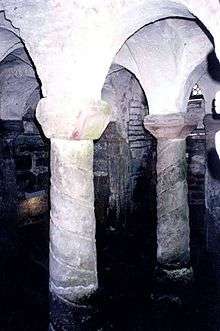 |
dedication unknown | c. 655 – 669 | An early- to mid-7th-century double monastery of Celtic origin here provided the supposed[37] original see for Mercia. Four bishops of Mercia are named, before St Chad moved the see to Lichfield when he became bishop in 669,[38] though they may have been peripatetic (having no fixed see).[39] The Repton monastery was destroyed when a Danish army overwintered there in 873/4, though the c. 720 crypt of the abbey church (shown), survived and was used for Mercian royal burials. An Augustinian priory, founded c. 1158 and dedicated to St Wystan, used the same site (dissolved 1538).[40] Traces of priory buildings exist in Repton School (1559),[39] adjacent to St Wystan's church, now the parish church. | 52.84115°N 1.551695°W |
| St Germans, Cornwall | 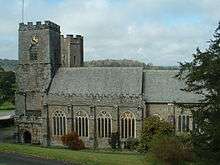 | Priory Church of St Germanus | early 10th century – c. 1027 | King Athelstan (of England - which by then included Cornwall) appointed Conan as Bishop of Cornwall in c.936, with his see at St Germans.[41] Some earlier bishops of Cornwall (after Kenstec) were probably also based at St Germans. Lyfing, Bishop of Crediton, became additionally Bishop of Cornwall in c.1027, uniting the two sees at Crediton. The former cathedral at St Germans became collegiate c.1050, then an Augustinian priory c.1184; this was dissolved 1539, leaving a parish church with some Norman fabric. | 50°23′48″N 4°18′35″W |
| Selsey, Sussex | 
|
Selsey Abbey (Abbey Church of St Peter?) | c. 681 – c.1075 | With the help of King Ethelwealh of Sussex, St Wilfrid founded a monastery and bishopric here in 681. He returned to the north c. 686, but the see was revived c. 709. It was translated to Chichester immediately following the Council of London in 1075. Centuries of coastal erosion seem to lie behind a tradition that the site of the cathedral is now under the sea.[42] Nevertheless, the leading contender for the cathedral's site[43] is the 13th-century St Wilfrid's Chapel, Church Norton (shown), which is the chancel left when the rest of the parish church there was dismantled (1864–66) and moved to Selsey village to become (with additions) the new parish church. The chapel was dedicated to St Wilfrid only in 1917.[44][45][46] | 50°45′18″N 0°45′55″W |
| Sherborne, Dorset |
|
Abbey Church of St Mary the Virgin | 705–1075 | In 705 the see was created for western Wessex, from part of the diocese of Winchester. In 909 new dioceses were created for Devon and Cornwall (at Crediton, though possibly at Tawton first), Wiltshire (at Ramsbury), and Somerset (at Wells), leaving the Sherborne see with Dorset only. Ramsbury rejoined Sherborne in 1058, and the see was translated to Old Sarum in 1075. Sherborne became a Benedictine priory in c. 993, and an abbey in 1122 (dissolved in 1539). Its church was bought by townspeople to be the parish church. Sherborne School incorporates some abbey buildings. | 50°56′48″N 2°31′00″W |
| Soham, Cambridgeshire |
|
dedication unknown | c. 630? and c. 900 – c. 950 | A monastery of c. 630 here, supposedly founded by St Felix, may have had an early cathedral for East Anglia (soon translated to Dommoc). It was destroyed by Danes c. 870, but when rebuilt c. 900 may have served as a cathedral then, when the sees of Dommoc and North Elmham had both ceased to function (and until eclipsed by Ely). Traces remain in St Andrew's parish church (shown) at co-ordinates stated.[47][48] | 52.333478°N 0.336942°E |
| Stow, Lincolnshire | 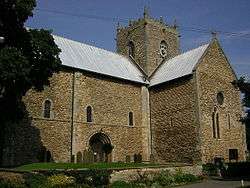 | Minster Church of St Mary | c. 680 – c. 875 | The Mercian diocese established by Chad at Lichfield was divided in 678 with a see created in Lindsey for the Bishop of Lindsey. But its location is unknown, and the view that the cathedral was at Stow is now largely discounted in favour of a site in Lincoln itself (so far unknown). The see of Lindsey suffered from Danish invasion, and so was translated to Dorchester on Thames in the mid-9th century. In its present form Stow Minster dates from the mid-10th century when, it is claimed, it effectively became a second cathedral for the north east of the Dorchester diocese, with several diocesan officers and clergy based there until the see of Dorchester was translated to Lincoln in 1067. It is now a parish church. | 53°19′39″N 0°40′38″W[49] |
| Tawton, (later Bishop's Tawton), Devon |
|
Dedication uncertain | c. 905 – c.909 | Several 16th/17th-century sources[50][51] record that the see for the first bishop for Devon (a diocese created by dividing the Diocese of Sherborne in the early 10th century) was at Tawton (later Bishop's Tawton).[39][52] The sources claim that Werstan held the office from its creation in 905 to his death in 906; his successor, Putta, was killed in 909 on his way to Crediton. His successor (Eadwulf) immediately moved the see to Crediton. Any link between a 10th-century bishop's church here and the extant parish church of St John the Baptist (shown) is conjectural. The case for a brief bishopric at Tawton is not certain, but there are remains of a modest "bishop's palace" at Court Farm, next to the church, used for centuries by the diocesan bishops, and the parish was a bishop's peculiar.[53] The co-ordinates given are for the 14th-century parish church, restored in the 19th century. | 51°03′08″N 4°02′53″W |
| Wells, Somerset |
|
Minster of St Andrew | 909 – 1175 | In c. 909 the Diocese of Sherborne, covering South-West England, was divided creating several new dioceses. Wells was chosen as the see for Somerset, and the town's minster, founded c. 705, became its cathedral. In 1090 a new bishop moved the see to Bath Abbey and built a new cathedral there. Despite Wells' loss of status, in 1176 a much larger building was begun, further north and on a different alignment, forming the basis of the present Wells Cathedral. (Wells became a cathedral city again in 1245.) The only accessible material from the Anglo-Saxon former cathedral is the supposed font (shown), dated c.700. The co-ordinates given are of the cloister garth where excavations of 1978-80 located foundations of the former cathedral, though they have been left almost undisturbed.[54][55] | 51°12′36″N 2°38′38″W |
| Welsh Bicknor, Herefordshire |  | Constantine[56] (Custenhinn) | 6th century - 8th? century | Welsh Bicknor is in the area of Archenfield (once part of the British-Welsh petty kingdom of Ergyng before the area became part of England). The British bishop-saint Dubricius (otherwise Dyfrig) (c. 465 - c. 550) founded several monasteries in the area and has been called the first bishop of Ergyng.[57][58] According to a charter in the Book of Llandaff his episcopal place (in Latin, "episcopalis locus") was at "Lann Custenhinn Garth Benni", which has been identified as Welsh Bicknor.[59][60] With very few local residents; its church, St Margaret's (shown), was closed by the Diocese of Hereford in 2010 and is now privately owned. Entirely new-built in 1858-59, it replaced a much older church on the same ancient site.. | 51.8561°N 2.5935°W |
Cathedrals founded (or proposed) between 1066 and 1539
survivors becoming Church of England at the Reformation
| Location | Image | Name | Dates | Notes | Coordinates |
|---|---|---|---|---|---|
| Bath, Somerset | 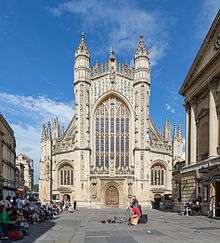 | Priory Church of St Peter & St Paul | 1090–1539 | Founded c. 676 for nuns (replaced c. 758 by monks), the abbey was later destroyed by Danes. Refounded c. 963 (Benedictine from c. 980), it was destroyed in 1087 and rebuilt. The see for Somerset was translated from Wells to Bath in 1090 and it became a cathedral priory. Bath was joint cathedral with Glastonbury 1195-1218, then co-cathedral with Wells from 1245. Wells was favoured by later bishops. Bath priory was dissolved 1539, the site sold, the buildings partially demolished. The church was given as a parish church in 1572. | 51°22′53″N 2°21′32″W[61] |
| Chester, Cheshire |    | Collegiate Church of St John the Baptist | 1075–1102 | By tradition, this was a minster founded by King AEthelred of Mercia in 689 on the site of an earlier church. Repaired and refounded c. 1057 by Leofric as a college, dedicated to The Holy Rood and St John the Baptist, it became the cathedral for the Mercian diocese when the see was translated to Chester from Lichfield following a decree of the Council of London in 1075.[62] The see was again translated by 1102 to Coventry, but some bishops of Coventry and Lichfield used the title of Bishop of Chester up to the Reformation. The Norman core of St John's remains in use as a parish church. The ruins to the east were left when the college was dissolved c. 1547. The west end has the base of the twice-collapsed (1574 and 1881) tower. The church was much restored 1859-66.[63] | 53°11′20″N 2°53′09″W |
| Coventry, (Warwickshire), West Midlands |  | Cathedral Priory of St Mary, St Peter and St Osburga[64][65] | 1102–1539 | A Benedictine abbey was founded 1043 on the site of a Saxon nunnery founded by St Osburga. The see of Lichfield, which was translated to Chester in 1075, moved to Coventry by 1102 (the diocese of Coventry and Lichfield thus having two cathedrals until 1539 when this cathedral priory at Coventry was dissolved). Money could not be found to save the priory church, so it was sold for demolition in 1545. Significant remains have been located and preserved (shown).[66] | 52.4089°N 1.5085°W |
| Glastonbury, Somerset | Glastonbury Abbey | 1195–1218 | Legend claims a 1st-century origin[67] for the monastic site, and evidence exists from the 6th century: it was Benedictine from 940. In 1195 the Bishop of Bath was also made Abbot of Glastonbury, styling himself Bishop of Bath and Glastonbury. This title persisted, though opposed by the monks, until 1218 when the pope found for them and the title reverted.[68] The Abbey was dissolved in 1539, and the site sold: it was bought in 1907 on behalf of the Church of England.[69] The extensive remains can be visited (entry charge). | 51.145648°N 2.715318°W | |
| Old Sarum, Wiltshire | 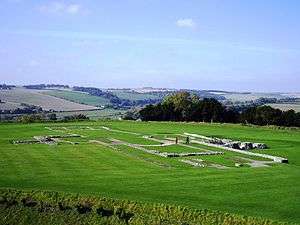 | Old Sarum Cathedral | 1075–1219 | The Normans built a castle and a cathedral on this Iron Age hillfort, and moved the see here from Sherborne in 1075. The cathedral was demolished and the see translated to Salisbury (New Sarum), 2 miles south, in 1219. The site of Old Sarum is in the hands of English Heritage, with extensive remains including the former cathedral's foundations (shown). | 51°05′39″N 1°48′23″W |
| Thetford, Norfolk | Minster of St Mary the Greater | 1072–c. 1094 | This minster was briefly the see for East Anglia, moved from North Elmham in 1072, then to Norwich c. 1094. The building (likely wooden at first) then housed a Cluniac priory in the early 12th century; the site was occupied by a Dominican friary from 1335 to dissolution in 1538. The exact location of the former cathedral is uncertain, but is believed to be near Thetford Grammar School (co-ordinates given) which incorporates some remains of the friary.[70] | 52.413527°N 0.744477°E | |
| Westbury-on-Trym, Gloucestershire | 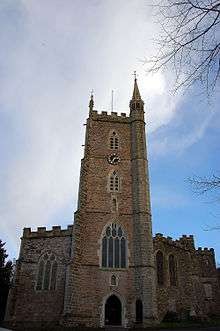 | Collegiate Church of The Holy Trinity | proposed | A minster was founded in c. 795, and re-founded as a Benedictine priory by Bishop Oswald of Worcester c. 962. The monks left to start Ramsey Abbey c. 974. A monastery was re-founded by St Wulfstan, Bishop of Worcester c. 1093, but the church became collegiate c. 1194. From 1286 Bp. Giffard of Worcester intended Westbury as a second cathedral, but he died 1302. A similar plan by Bp. Carpenter in 1455 led to enlargement of the college, a change of dedication from "St Mary" to "Holy Trinity", and his use of the title "Bishop of Worcester and Westbury", but this last ceased on his death 1476. The college was dissolved 1544, becoming a parish church with no pre-1194 fabric now visible. Some former collegiate buildings survive nearby.[71][72] | 51.49395°N 2.616°W |
Cathedrals founded (or proposed) from 1540 to the present
Church of England from their foundation or when proposed
The cathedrals of St Albans and Southwell qualify for inclusion here because the 1540 proposals to raise them to cathedral status failed, as for many others in this section of the list. Later proposals succeeded in elevating them in 1877 and 1884 respectively, so they will be found also in lists of extant cathedrals.
| Location | Image | Name | Dates | Notes | Coordinates |
|---|---|---|---|---|---|
| Aldfield, North Yorkshire |  | Abbey Church of St Mary | proposed | Known as Fountains Abbey, a Cistercian house of 1132, dissolved 1539. In 1540 Henry VIII chose the abbey church as cathedral for a new diocese to cover Lancashire plus some parts of Yorkshire and much of Cumberland and Westmorland.[73] The proposal was abandoned and the site sold, in favour of the new diocese of Chester, covering the same ground plus Cheshire.[74] Extensive remains are in the hands of the National Trust. | 54°06′36″N 1°34′53″W |
| Bury St Edmunds, Suffolk |  | Abbey Church of St Mary & St Edmund | proposed | Founded c. 633, the remains of St Edmund, martyred in 870 were brought here in 903. The church became collegiate c. 925., then a Benedictine abbey in 1020, dissolved in 1539. Henry VIII proposed the abbey church as a cathedral in 1540,[73] but the site was sold and robbed of stone. The extensive ruins[75] (shown) are in the hands of the National Trust. | 52.2441°N 0.7192°E |
| Colchester, Essex | 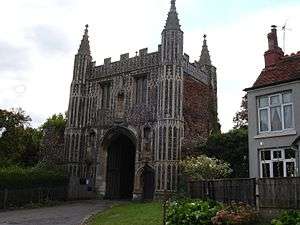 | Abbey Church of St John the Baptist | proposed | A Benedictine monastery founded here in 1096 was dissolved in 1539. The abbey church was proposed as a cathedral for Essex (probably as a substitute for Waltham Abbey) in c. 1540.[73] Only the 15th-century abbey gatehouse (shown) remains (in the hands of English Heritage), other buildings were believed destroyed in the English Civil War siege of 1648. The site has been in military use since the mid-1800s. | 51.885544°N 0.901297°E |
| Coventry, (Warwickshire), West Midlands | 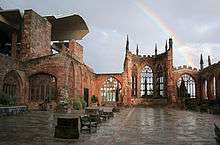 | St Michael's Cathedral | 1918–1940 | This was a very large medieval parish church, dating from c. 1300. Collegiate from 1908, it became a cathedral in 1918 when the modern Diocese of Coventry was created. It was fire-bombed in 1940. (The new cathedral of St Michael, built 1951-1962, adjoins the ruins.) Extensive remains include the 14th-century tower with 15th-century spire.[76] | 52°24′29″N 1°30′27″W |
| Dunstable, Bedfordshire |  | Priory Church of St Peter | proposed | An Augustinian house of canons founded by 1125. Dissolved in 1540, the priory church was proposed by Henry VIII 1540 as a cathedral for Bedfordshire.[77] Instead, the nave became a parish church.[78] | 51.886°N 0.5176°W |
| Guildford, Surrey | 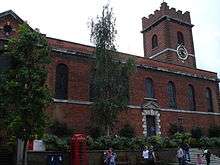 | Holy Trinity Church | 1927–1961 | The current parish church, completed 1763, replaced a mediaeval, possibly Norman, church destroyed 1740 by the collapse of its steeple. Only the Weston Chapel (c. 1540) remains from the earlier building. Holy Trinity was the pro-cathedral for the new Diocese of Guildford from its creation in 1927 until the dedication of the new cathedral in 1961. | 51°14′09″N 0°34′15″W[79] |
| Guisborough, North Yorkshire | 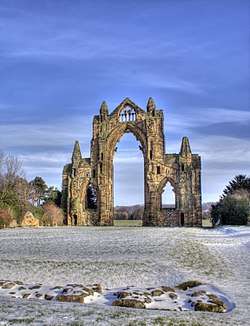 | Priory Church of St Mary | proposed | The Augustinian priory, founded 1119, was dissolved in 1540. It was among the c. 1540 proposals for new cathedrals,[73] but instead its buildings were largely demolished.[80] Remains (shown) are in the hands of English Heritage. (The town's name is Guisborough, but the priory's historic name is Gisborough). | 54.535833°N 1.048889°W |
| Launceston, Cornwall | Priory Church of St Stephen | proposed | An Augustinian priory, founded in 1127 was dissolved in 1539. The priory church was proposed in 1540 as a cathedral for Cornwall by Henry VIII,[73] but did not proceed. Some remains exist. For more details, see Launceston Priory article.. | 50.636472°N 4.355417°W | |
| Leicester, Leicestershire | 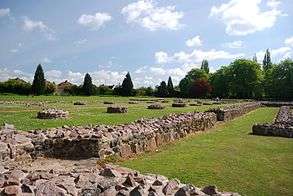 | Abbey Church of St Mary de Pratis (St Mary of the Meadows) | proposed | An Augustinian house of 1143, Cardinal Wolsey died here in 1530. Dissolved in 1538, the abbey's church was listed among Henry VIII's 1540 proposals as a cathedral for Leicestershire,[77] but the site had been disposed of by then.[81] Abbey Park (public) contains some remains: the abbey's perimeter walls plus its conjectured foundations (shown) | 52.648683°N 1.136856°W |
| Liverpool, (Lancashire), Merseyside |  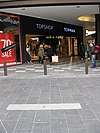 | Pro-Cathedral of St. Peter | 1880–1919 | St Peter's church (shown) was built 1704, as a second parish church for Liverpool, in addition to the much older church of Our Lady & St Nicholas, near the docks. After rapid industrialisation and population growth, the Diocese of Liverpool was created 1880 (out of the see of Chester), and St Peter's was designated its pro-cathedral. Building of a new cathedral began 1904. In 1919 it opened for worship and St Peter's closed, to be demolished in 1922 for retail use. Today the only visible sign that the church ever existed is a stone with an inlaid brass cross set in the paving of Church Street, at its junction with Keys Court (shown), leading to Peter's Lane, all now (2017) in the 'Liverpool ONE' shopping area. The slab, it is said, marks the position once occupied by St Peter's High Altar. | 53°24′18″N 2°59′03″W |
| Nottingham, Nottinghamshire | 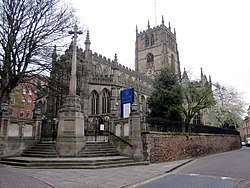 | Church of St Mary the Virgin | proposed? | The original parish church of Nottingham, probably founded in the 7th century and mentioned in the Domesday Book, St Mary's is located close to the centre of the original Anglo-Saxon settlement. The large building dates from the 14th century and later, with a 15th-century chancel and significant 19th-century work. In the late 19th century the creation of a diocesse for Nottinghamshire was being considered, and St Mary's future elevation was widely assumed. Bodley installed a canopied chair (now (2019) at the south-east corner of the choir) to be the new bishop's cathedra.[82] However, Southwell Minster, 14 miles north of Nottingham, was raised to cathedral status in 1884, rather than St Mary's. | 52.951111°N 1.143°W |
| Osney, Oxfordshire | 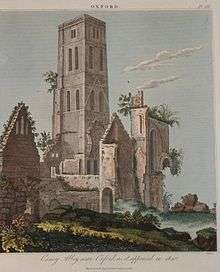 | Abbey Church of St Mary | 1542–1545 | An Augustinian priory founded in 1129, raised to abbey status c. 1154, but dissolved in 1539. Under 1540 proposals of Henry VIII,[77] the abbey church became the cathedral for Oxfordshire in 1542, but was closed in 1545 and the see translated to Christ Church Cathedral, Oxford. The monastic site probably extended from the (later) Osney Mill on the River Thames in the west to the 19th-century Osney Cemetery and railway line to the east. The cemetery and railway line likely cover the site of the abbey church, the only known visible remains of the abbey complex being a small ancillary building of c. 1410 at Osney Mill. | 51°44′59″N 1°16′12″W |
| St Albans, Hertfordshire | 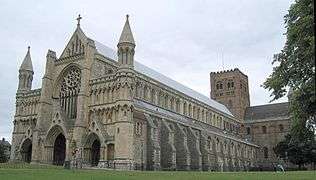 | Abbey Church of St Alban | proposed | A Benedictine abbey founded 793, it was dissolved 1539. Henry VIII proposed the abbey church as Hertfordshire's cathedral in 1540,[77] but instead it was sold in 1553 to the townspeople to become the parish church.[83] (It remained so until 1877 when it became a cathedral.) | 51.750278°N 0.342222°W |
| Shrewsbury, Shropshire | Abbey Church of St Peter & St Paul | proposed | A Benedictine abbey was founded in 1083 (on the site of the Anglo-Saxon church of St Peter), dissolved in 1539. The abbey church was proposed in 1540 as a cathedral for Shropshire by Henry VIII,[73] but only the nave was retained as a parish church. A new choir and chancel were added during a late 19th-century restoration.[84] A 1922 proposal for cathedral status (in a new diocese) was rejected by one vote in the House of Lords in 1926. | 52°42′27″N 2°44′38″W | |
| Southend-on-Sea, Essex | St Erkenwald's Church | proposed? | This was a very large church built 1905-1910, and soon anecdotally considered by some, including its first incumbent, as a potential cathedral. It fell into disrepair, was declared redundant in 1978, and was demolished in 1995 after a severe fire.[85] | 51°32′12″N 0°43′27″E | |
| Southwell, Nottinghamshire |  | Collegiate Church of the Blessed Virgin Mary | proposed | Unsuccessfully proposed by Henry VIII for cathedral status in 1540, this church was raised to that status in 1884. For a description and history refer to Southwell Minster. | 53.076667°N 0.953889°W |
| Waltham Abbey, Essex | Abbey Church of Waltham Holy Cross & St Lawrence | proposed | A minster on this site was founded c. 610 but abandoned 617, then re-established in the mid-8th century. Enlarged c. 1060, supposedly by King Harold II, who some legends say was buried here after his defeat by William the Conqueror in 1066. It became an Augustinian priory in 1177, an abbey in 1184, but was dissolved in 1540. Proposed the same year as a cathedral by Henry VIII without success,[77] only the nave was saved as a parish church.[86] It was a Royal Peculiar 1184-1865. | 51.6875°N 0.0035°W[87] | |
| Welbeck, Nottinghamshire |
|
Abbey Church of St James the Great | proposed | A Premonstratensian abbey founded in 1140, it was dissolved in 1538. Proposed in 1540 by Henry VIII as a cathedral for Nottinghamshire,[88] but the site was sold. The mansion later built on the site (shown) has traces of the former abbey. | 53.262222°N 1.156111°W |
| Westminster, London | 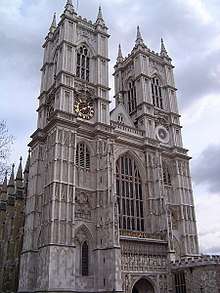 | The Collegiate Church of St Peter, Westminster[89] | 1540–1550 | An abbey founded in the 7th century, it was destroyed by Danes in the 9th century. Refounded c. 959, the abbey was suppressed in 1540 but its church immediately became one of Henry VIII's new cathedrals,[77] the second for London (after St Paul's). Cathedral status was removed in 1550. Re-established as a Benedictine monastery by Mary I in 1556, it was dissolved in 1559, becoming a collegiate church in 1560 but still universally known as Westminster Abbey. It is a Royal Peculiar. | 51°29′58″N 0°07′39″W |
Post-Reformation Roman Catholic Cathedrals
| Location | Image | Name | Dates | Notes | Coordinates |
|---|---|---|---|---|---|
| City of London, London |  | St Mary's Church, Moorfields | 1852–1869 | Built in 1820 to replace the church destroyed by the Gordon Riots. It was the first pro-cathedral of the Archdiocese of Westminster. It was superseded by Our Lady of Victories Church and demolished in 1900. The present St Mary's Church was opened in 1902.[90] | 51°31′7.64″N 0°5′8.57″W |
| Clifton, Bristol | Pro-Cathedral of the Holy Apostles | 1850–1973 | Building of a church started 1834, but unstable ground delayed completion (of a smaller church) until 1847. It became the pro-cathedral in 1850, and was closed in 1973 when it was replaced by the new Clifton Cathedral. Following a series of secular uses, the building was developed for housing and offices c. 2014. | 51.456297°N 2.609720°W | |
| Hereford, Herefordshire | Abbey Church of St Michael and All Angels | 1854–1920 | The Diocese of Newport and Menevia was created in 1850 but with no official seat. In 1854 building began when it was agreed that this would be the pro-cathedral.[91] In 1859 it became a Benedictine priory, consecrated 1860. The see was translated to St David's Metropolitan Cathedral, Cardiff in 1920. It is now Belmont Abbey. | 52.03932°N 2.756412°W[92] | |
| Kensington, London | 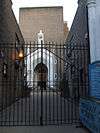 | Our Lady of Victories Church | 1869–1903 | It was the pro-cathedral for nearly thirty-six years until Westminster Cathedral in London was opened in 1903 | 51°29′57″N 0°11′52″W[93] |
| Liverpool, (Lancashire), Merseyside | Pro-Cathedral of St. Nicholas | 1850–1967 | Built in 1813, it was replaced by Liverpool Metropolitan Cathedral in 1967. It was then a parish church for the Archdiocese of Liverpool until its demolition in 1973 | 53°24′25″N 2°58′30″W[94] | |
| Middlesbrough, North Yorkshire | Our Lady Of Perpetual Succour | 1878–1983 | It was the pro-cathedral until the Roman Catholic see was translated to Coulby Newham in 1983. The former site was redeveloped following the demolition of the building after damage from an arson attack on 30 May 2000. | 54°34′48″N 1°14′13″W | |
| Plymouth, Devon | Our Lady and St John the Evangelist Church | 1850–1858 | Known as St. Mary's Church, it opened on 20 December 1807 and was pro-cathedral for the Diocese of Plymouth from 1850 to 1858, when Plymouth Cathedral was opened. The church was then remodelled and given to the Little Sisters of the Poor. In 1884, they left and it was converted into housing. It was demolished in 1960.[95] | 50.3703°N 4.1593°W | |
| Southampton, Hampshire | 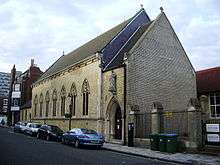 | St Joseph's Church | 1882 | It served as the pro-cathedral from May to August 1882, until the Cathedral of St John the Evangelist, Portsmouth was completed.[96] | 50.899072°N 1.405937°W |
| Southwark, London | Archbishop Amigo Jubilee Hall | 1942–1958 | It served as the pro-cathedral during the rebuilding of the adjacent cathedral following its destruction during World War II | 51.456297°N 2.609720°W | |
| York, North Yorkshire | 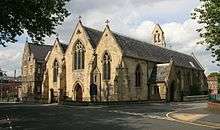 | St. George's Church | 1850–1864 | It served as the pro-cathedral for the Diocese of Beverley until the construction of St. Wilfrid's in York. | 53.9550°N 1.0758°W[97] |
| York, North Yorkshire | St Wilfrid's Church | 1864–1878 | It succeeded St George's as pro-cathedral for the Diocese of Beverley until in 1878 the diocese was split into the Diocese of Leeds and the Diocese of Middlesbrough. | 53.961900°N 1.084700°W[98] |
Isle of Man
The Isle of Man is not part of Great Britain (nor the United Kingdom) politically, but it is ecclesiastically. For the Church of England it forms the Diocese of Sodor and Man in the Province of York;[99] for the Roman Catholic church, it is in the Archdiocese of Liverpool. The long-standing political status of the Isle of Man is that of a Crown Dependency.
| Location | Image | Name | Dates | Notes | Coordinates |
|---|---|---|---|---|---|
| Kirk Michael | The Chapel of St Nicholas at Bishopscourt | 1895-1979 | Bishopscourt was the residence of the Bishop of Sodor and Man in 1230 and from c. 1700[100] until it was sold in 1979. In 1895 the chapel was designated as pro-cathedral by Bishop Straton. Bishopscourt is now privately owned, with no public access. | 54.299722°N 4.654167°W | |
| Peel | 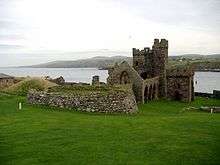
|
St German's Cathedral, Peel Castle | 5th century? then 12th century – 1895 | Tradition tells that Saint Patrick built a cathedral on a small tidal islet off the coast, later called St Patrick's Isle. Stone monastic buildings followed in c. 900. A new cathedral of St German was established there by the 13th century for the island's Diocese of Sodor and Man (which once included the Scottish Hebrides - called Sodor from their Norse name - together with Man, which had all been under Norwegian rule for some two centuries before being ceded to Scotland in 1266). In the 14th century the Isle of Man came under English control while Scotland retained the Hebrides, so the diocese then became restricted to the Isle of Man alone. By 1780 the cathedral was an unusable ruin,[101] and later bishops were enthroned at St Mary's, Castletown (now Old St Mary's) or (after 1895) at St George's, Douglas until the parish church of St German, built 1879-1884 in the City of Peel, was raised to cathedral status in 1980. Peel Castle, including the monastic and old cathedral ruins, is cared for by Manx National Heritage. | 54.226217°N 4.698144°W[102] |
Scotland
Pre-Reformation Cathedrals (or proposed Cathedrals)
survivors becoming Church of Scotland at the Scottish Reformation (1560)
For various reasons,[103] formal dioceses were formed later in Scotland than in the rest of Great Britain. Bishops certainly existed in areas from the earliest Christian times (often from Irish monastic missionary activity), but the territory over which an early (often monastic) bishop operated was limited and ill-defined. Hence the term "bishop's church" is sometimes used for a seat used by an early bishop rather than the word "cathedral" which some expect to be attached to a formal diocese. Traditionally, the medieval Scottish diocesan system was held to have been largely created by King David I (reigned 1124-1153), though this is an oversimplification.
As the Scottish Reformation of 1560 developed, bishops and cathedrals became progressively marginalised and neglected. By Act of the Scottish Parliament 1690 (confirming the Church's own final decision of 1689) the Church of Scotland finally became wholly Presbyterian, with no dioceses, no bishops, so no functioning cathedrals. At that date all Church of Scotland cathedrals became former cathedrals. Some still use the title, but for honorific purposes only.
The Scottish Episcopal Church and the Roman Catholic Church in Scotland maintain their own diocesan structures with their own cathedrals and bishops.
| Location | Image | Name | Dates | Notes | Coordinates |
|---|---|---|---|---|---|
| Abercorn, West Lothian | dedication unknown | 681-685 | A monastery was founded c. 675 by St Wilfrid near the northern extremity of the newly expanded Anglo-Saxon Kingdom of Northumbria. In 681 St Trumwine from Lindisfarne was appointed "Bishop of those Picts who were then subject to English rule"[104] i.e. those north of the River Forth paying tribute to Northumbria. In 685 he abandoned his see to the Gododdin people following the defeat of the Northumbrians by the Picts at the Battle of Nechtansmere.[105] The existing kirk (12th century and later, shown) is on or very close to the monastic site.[106] | 55.99334°N 3.47326°W[107] | |
| Aberdeen, Aberdeenshire | 
|
Cathedral Church of St Machar | 1131-1690 | (Diocese of Aberdeen) Legend tells of a church founded 580 by St Machar in Old Aberdeen. In 1131 a Norman cathedral was built (same dedication) when the see was translated from Mortlach (now Dufftown). Since the Reformation it has been the High Kirk of Aberdeen. For more details, see St Machar's Cathedral. | 57.169700°N 2.102069°W[108] |
| Abernethy, (Perthshire), Perth and Kinross | dedication unclear | early 8th century – 11th century? | Once an important centre for the Picts, the history of a supposed bishopric here is obscure. No bishops' names are known for certain, but Fergus may have been one of three during the early 8th century.[109] Any bishopric had moved to Muthill by the 12th century. The original church of St Brigid, said to be 6th century, may have been a bishop's church. A small Augustinian priory of 1272 likely included Culdees, possibly associated with the 11th-12th century[110] round tower, now cared for by Historic Environment Scotland. The priory, which was suppressed and replaced by lay canons in the 15th century, may have used the ancient church. It was in ruins by 1802, when the current parish kirk of St Brigid was built nearby, the older site then being used for burials.. | 56.333143°N 3.311670°W[111] | |
| Birnie, Elgin, Moray | 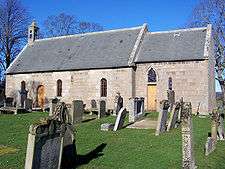 | St Brendan's Church | c. 1140–1184 | (Diocese of Moray) The first bishop of the diocese, Gregory c. 1120,[112] may have used this, likely Culdee, church, built c. 1140, as his bishop's church (or proto-cathedral). The bishopric moved to Kinneddar after the death of Bishop Simon in 1184. The building is still in use as the parish kirk. | 57°36′41″N 3°19′48″W[113] |
| Birsay, Orkney | St Magnus' Kirk[114] | mid-11th century – 1137 | (Diocese of Orkney) It has been said that the original church here, dedicated as Christ's Church or Christchurch, was built by Earl Thorfinn c. 1060, and used by several early bishops. Its exact location is disputed, some claiming it was on the Brough of Birsay, a tidal island just offshore,[110] but the balance of evidence favours a mainland location here, close to the ruined palace of the 16th-century Stewart Earls of Orkney.[115] The much-rebuilt church, likely re-dedicated following the reburial of St Magnus here soon after his murder on Egilsay, is almost certainly where Thorfinn's church stood. There is evidence of a bishop's residence nearby. | 59.129444°N 3.316389°W | |
| Brechin, Angus |  | Cathedral of the Holy Trinity | ante 1150 | (Diocese of Brechin) The former cathedral building, now Brechin High Kirk, dates from the 13th century. The site was formerly occupied by a Culdee monastery, possibly derived from Abernethy. After the Scottish Reformation the choir was abandoned and the rest of the building suffered from neglect. A much-criticized reconstruction completed 1806 was repaired and improved by more sensitive restoration 1900-1902. Original parts remaining include the western gable and massive square tower, parts of the choir, the nave pillars and clerestorey. Next to the church is a very fine round tower, superior to the Abernethy example, some 26.2m high, 4.9m diameter, dating from c. 1000, and cared for by Historic Environment Scotland. | 56.730694°N 2.662125°W |
| Dornoch, (Sutherland), Highland | 
|
St Mary's Cathedral | 1239–1689? | (Diocese of Caithness) After earlier "bishop's churches" (such as St Peter's, Thurso; St Thomas's, Skinnet; and possibly a church at Halkirk), the only designated cathedral for Caithness was begun by Gilbert, the fourth bishop. The work on, or at least the planning of, the cathedral probably began soon after Bishop Gilbert's elevation c. 1223, following the maiming of the second bishop (John) and the murder of the third (Adam). The choir was completed by 1239, when Bishop Adam's remains were removed from Skinnet and re-interred here. The nave appears to have been roofed soon after 1291:[116] it collapsed c. 1428, but was repaired. In 1570 a local feud severely damaged the whole building by fire, though all but the nave was restored by the Earl of Sutherland 1614-22. The nave was drastically rebuilt on a narrower plan 1835-1837 by a later Countess of Sutherland, in part to create a family mausoleum. The building remains in use as a parish kirk. | 57.880729°N 4.030695°W[117] |
| Dunblane, Stirling | 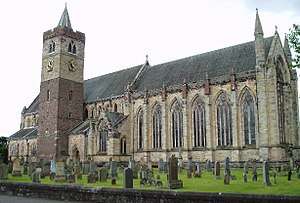
|
Cathedral Church of St Blaan and St Laurence[118] | 1155-1689 | (Diocese of Dunblane) Outwith the traditional link with St Blane in c. 600, the site boasts burial cross slabs confirming the presence of a Christian community here by the 9th century. The earliest bishop of Dunblane of whom we are certain was Laurence in 1155. That date also fits both the (lower part of the) tower attached to the cathedral's nave and the similar (but smaller) tower at Muthill, suggesting that both sites may once have been used together.[119] A friar named Clement became bishop in 1233; he reversed earlier diocesan decline, and began construction of the present building. The late 15th century and the first half of the 16th brought more building work, including the upper third of the tower. After the Reformation the nave became unused and its roof gradually fell down during the 17th century.[120] The choir was restored 1816-1819, followed by restoration of the nave 1888-1893. The whole site is cared for by Historic Environment Scotland[119][121] | 56.189550°N 3.964949°W |
| Dunkeld, (Perthshire), Perth and Kinross | 
|
St Columba's Cathedral | 9th century c. 1120 – 1689 | (Diocese of Dunkeld) Tradition tells of a monastery founded by the early 7th century after a visit by St Columba, who was based at Iona. By the 9th century the site had a stone-built Culdee monastery possessing relics of St Columba. In c. 869 its abbot was described as the chief bishop of the kingdom,[122] but very soon after St Andrews became the chief bishopric of the Scottish church. The cathedral was re-founded in the 12th century, though most surviving fabric dates from the 15th century (there are traces of Culdee stonework). In the Scottish Reformation the nave was unroofed, but the 13th-century choir has been used ever since as the parish kirk. The cathedral ruins (but not the choir) are in the care of Historic Environment Scotland. | 56°33′54″N 3°35′23″W |
| Egilsay, Orkney | 
|
St. Magnus' Church | It seems unlikely that this island church ever was a cathedral for the Bishop of Orkney, but "it may have been regarded as a bishop's church".[123] The ruined mid-12th-century church commemorates the killing here of St Magnus by his brother c. 1118, and is usually dated decades later than 1135 when Magnus was sainted. He spent the night before his murder in a church on Egilsay,[124] its site probably reused for this church. His body was buried on Egilsay, reburied at Birsay, and finally moved to Kirkwall. Unused since the early 19th century, the church (now unroofed with its round tower, unique in Orkney, reduced in height) is in the care of Historic Environment Scotland. | 59.1569°N 2.9353°W | |
| Elgin, Moray |  |
Cathedral of the Holy Trinity | 1224–c. 1560 | (Diocese of Moray) Building began promptly when Bishop Andrew received papal permission in 1224 to move the see from Spynie to Elgin. A fire in 1270 saw the rebuilt cathedral enlarged and a Chapter House added.[125] More building work followed another fire in June 1390, the result of an attack by Alexander Stewart, Earl of Buchan. Some further development took place during the 15th century, the last being a restructuring of the Chapter House 1482-1501. At the Reformation the cathedral was totally abandoned in favour of the 12th-century parish kirk of St Giles, the building left to decay and collapse. There are impressive ruins in the care of Historic Environment Scotland. | 57°39′02″N 03°18′20″W |
| Fortrose, (Ross), Highland | 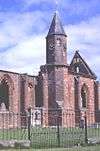 | Cathedral of Saint Peter and Saint Boniface of Fortrose | mid-13th century – mid-17th century | (Diocese of Ross) The see was moved here in the first half of the 13th century from Rosmarkie to a new red sandstone building consisting of a rectangular nave and choir, with (externally) a NW tower and a NE sacristy-cum- chapter house. A SW aisle and chapel were added in the 14th century.[125] Ruins of the last two parts remain. Ecclesiastical use of the building may have continued for a while after the Scottish Reformation of 1560, but between then and c. 1650 (when the main structure was robbed of stone for Cromwell's citadel in Inverness) it was used as the burgh's town hall and prison. The ruins are in the care of Historic Environment Scotland.[126] | 57.580885°N 4.130495°W |
| Glasgow | 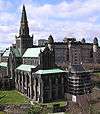 | St Mungo's Cathedral | 1114-1689 | (Diocese, then from 1492-1689 Archdiocese of Glasgow) Tradition has a church settlement founded here by St Mungo in the 6th century, from which Glasgow developed. The diocese began with the appointment of Bishop John (1114-1147); suggested earlier bishops were not Glasgow-based.[125][127][128] Most of the cathedral fabric is 13th-century, though the central tower and spire are 15th-century, and the Blackadder Aisle dates from c.1500. Exceptionally among pre-Reformation Scottish cathedrals, Glasgow's was never unroofed, which helps to explain its good and complete condition. The tomb of St Mungo is in the crypt. The building, which forms the High Kirk of Glasgow, is owned by the Crown and maintained by Historic Environment Scotland. | 55.862966°N 4.234436°W |
| Halkirk, (Caithness), Highland |  | dedication uncertain | Tradition tells of a church founded here by St Fergus in the early 8th century, before Caithness fell under Norse control. Claims that the cathedral of the Bishop of Caithness[110] was located here are unresolved. Halkirk was one part of the large parish of Skinnet until the 13th century.[129] Clearly there was a bishop's residence here as the third bishop, Bishop Adam, was murdered in his Halkirk kitchen in 1222. His body was taken to nearby Skinnet for burial.[130] Halkirk and Skinnet became separate parishes in the 13th century, but were reunited by 1538 as the parish of Halkirk.[131] The parish church was replaced in 1753 on the same site by a new kirk, declared redundant in 1934 and called "Halkirk Auld Kirk" (shown). No pre-1753 remains are known. | 58.5169°N 3.4863°W | |
| Hoddom, (Dumfriesshire), Dumfries and Galloway | dedication unknown | late 6th century | A cathedral was said to have been founded here in the late 6th century by St Mungo.[132] Any cathedral seems not to have survived his death in 612, but a monastery developed.[133] A parish church was built on the site in the 12th century, replaced after the Scottish Reformation by a new kirk of 1609 nearer to Ecclefechan at Hoddom Cross (burnt down in 1975). The co-ordinates given are for the former monastic site. | 55.041563°N 3.305430°W | |
| Kingarth, Argyll and Bute | 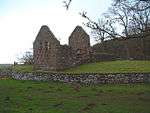 | Monastery of St Blane | 6th century | A monastery was reputedly built here by Saint Cathan. He was succeeded as bishop by his nephew Saint Blane. It was a cathedral until St Blane's death c. 590. The monastery was destroyed by Viking raids c. 790. A new church was built on the site in the 12th century, but fell out of use after 1560. Ruins (shown) are in the care of Historic Environment Scotland.[134] | 55.75°N 5.03°W |
| Kinneddar, Moray | 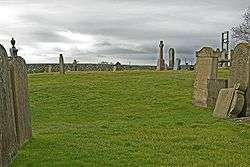 |
Kirk of Kinneddar | c. 1187 – c. 1208 | (Diocese of Moray) Shortly after 1184 the seat of the Bishop of Moray was moved from Birnie to Kinneddar.[135] Kinneddar Castle, adjacent to the new cathedral, became a residence of the bishop from 1187 until the late 14th century: now hardly a trace remains. The seat of the bishop, however, was moved again c. 1208 to Spynie by Bishop Bricus (1203-1222).[136] Following the Scottish Reformation the former cathedral was abandoned in favour of a new kirk at Drainie when parishes were merged c. 1669. A mound in the old churchyard at Kinneddar (shown), used for later burials, was confirmed by surveys as covering the foundations of the former cathedral. | 57.709451°N 3.305645°W |
| Kirkwall, Orkney | 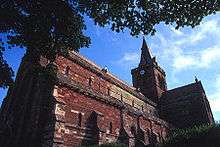
|
St Magnus' Cathedral | 1137–1689 | (Diocese of Orkney) In 1135 the bones of the newly sainted St Magnus (murdered on Egilsay c. 1118) were moved from the cathedral at Birsay to the church of St Olaf near Kirkwall (of which only a sandstone arch remains). The building of a cathedral at Kirkwall, dedicated to St Magnus, began in 1137, at the instigation of his nephew, St Ronald of Orkney and of William the Old, Bishop of Orkney. Consecration, with the translation of St Magnus' relics from St Olaf's, probably took place before 1151, when both protagonists left on Crusade. Further building was done during the next four centuries.[137] Restorations during the 19th and 20th centuries led to the discovery of supposed relics of St Ronald and St Magnus[138] in pillars in the choir, the oldest part of the cathedral. The building houses a congregation of the Church of Scotland, but under a 1486 Charter of King James III it is owned by the town of Kirkwall. | 58°58′56″N 2°57′32″W |
| Lismore, Argyll and Bute | 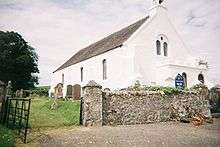 | Lismore Kirk | c. 1200 – c. 1650 | (Diocese of Argyll) By tradition chosen by St Moluag in the 6th century for a monastery, Lismore became the see of a bishop in the 12th century when the Diocese of Argyll was created from the western portion of the Diocese of Dunkeld. The 14th-century cathedral was small and simple, and the new diocese poor, leading to proposals to translate the see to Saddell (which never happened). The cathedral was abandoned after the Reformation; the whole building roofless by 1679,[139] the tower and nave later razed (outlines can be seen). The choir was restored to be used as the parish kirk. | 56°32′4″N 5°28′50″W |
| Madderty, (Perthshire), Perth and Kinross |
|
Inchaffray Abbey Church of the Virgin Mary and St John the Evangelist | proposed | In c. 1200 Gilbert, Earl of Strathearn, founded an Augustinian priory on a site which already had a church (dedicated to St John) and "a group of ecclesiastics known in contemporary documents as 'brethren'",[140] probably Culdees. The priory became an abbey c. 1220. By c. 1230 Dunblane Cathedral was roofless and had few staff,[141] so in 1237 it was proposed that the see of Dunblane be transferred to Inchaffray Abbey. However, Bishop Clement of Dunblane (1233–58) resolved the situation at Dunblane and the proposal was abandoned. For some time the Abbey remained large and relatively well-off, but by the time of the Scottish Reformation in 1560 it was among the poorest.[142] A few ruins remain on farmland (shown). | 56.3836°N 3.6954°W |
| Mortlach, (now Dufftown), Moray |
|
St Moluag's Cathedral | 1011 to 1131 | (Diocese of Aberdeen) The Chronicle of John of Fordun records the establishment of an episcopal seat in Mortlach aided by Malcolm II of Scotland, c. 1011. The see was translated to Aberdeen in 1131.[143] The placename of Mortlach was superseded in 1817 when a new village of Dufftown was created to the immediate north of the church (now located in the Dufftown district known as Kirktown of Mortlach). The parish kirk, much rebuilt, is on the cathedral's original site, and contains some ancient fabric. | 57.44078°N 3.12613°W |
| Muthill, (Perthshire), Perth and Kinross |  | dedication unknown | c. 12th century | (Diocese of Dunblane) Culdees were here in the 12th century[144] when Abernethy's bishopric moved to Muthill. The bishops based here often took the title "Bishop of Strathearn". They had moved to Dunblane by the 13th century, leaving their cathedral here, with its distinctive tower, as a parish church. Enlarged in the 15th century, it was abandoned for a new kirk built 1826-28. It is now in the care of Historic Environment Scotland. | 56.326164°N 3.832428°W |
| Rosemarkie, (Ross), Highland | Cathedral Church of St Peter | early 8th century and 1124 until mid-13th century | (Diocese of Ross} A monastic cathedral was reputedly founded by St Curetán (also known as St Boniface) as Bishop of Ross in c. 716. The Diocese of Ross was restored by David I of Scotland in 1124. Remains of Curetán's church have been found and placed in the current parish kirk, built in 1821 on the same site. In the mid-13th century, Fortrose Cathedral was built 2 km ESE, and the see was translated there.[145] | 57.59162°N 4.11516°W | |
| Saddell, Kintyre, Argyll and Bute |
|
Saddell Abbey | proposed | A Cistercian monastery founded in 1160, completed 1207. In 1249 it was proposed that the seat of the Bishop of Argyll should move here from Lismore because of the latter's then ruinous state. This did not happen then, but in 1507 King James IV declared that Sadell's monastic life had ceased and he transferred the Abbey's lands to the Bishop of Argyll who, in 1508, built a residence here using stone from the defunct Abbey. In 1512 James IV once more tried to have the see of Argyll moved to Sadell, but again no move took place and the Abbey fell further into ruin. The site eventually became a graveyard but some Abbey remains (shown) can be found. | 55.531944°N 5.511389°W |
| St Andrews, Fife | 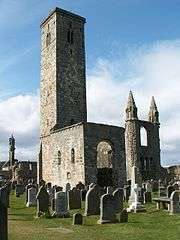 |
Church of St Regulus (or St Rule) | c. 1070[146] – early 14th century | (Diocese of St Andrews) Named for a legendary 4th-century Greek who, one tradition says, brought bones of St Andrew to Scotland. A more likely source of the relics is said to be Bishop Acca of Hexham (also dedicated to St Andrew), who was deposed in 732, returned to Scotland, and died 740.[147][148] Somehow relics arrived by the 8th century on the coast at Kilrymont (or varieties of the name), a place later called St Andrews because of his relics. A monastery on the shore, which survived as the Church of St Mary on the Rock, may have cared for the relics[149] before they were enshrined in a cathedral. The first cathedral at St Andrews, dedicated to St Regulus, was built maybe c. 1070.[150] Bishops of St Andrews, the chief centre of the Scottish church by the mid-9th century,[147] are recorded from c. 1028[151] though no cathedral earlier than that of St Regulus is known. Strongly built of squared ashlar blocks as a tower and chancel, it had a nave added to the west and a probable presbytery to the east c. 1144 when it became an Augustinian cathedral priory. The original tower and (unroofed) chancel stand in the precincts of the later cathedral of St Andrew, all in the care of Historic Environment Scotland. | 56.33965°N 2.786383°W |
| St Andrews, Fife |  |
St. Andrew's Cathedral | early 14th century-1560 | (Diocese, then Archdiocese of St Andrews from 1472-1689) Work began in 1158 on a successor Augustinian cathedral priory to St Regulus, and it was planned on a grand scale, as the pre-eminent bishopric in Scotland. It was finally consecrated in 1318, the largest church ever built in Scotland. Several mishaps occurred during construction and later: the west end blew down c. 1270; it was damaged by fire in 1376; the south transept blew down in 1409. At the time of the Reformation mobs attacked and looted the cathedral in 1559; by 1561 it was a ruin used as a quarry for stone and later as a burial place.[149] The large site enclosing the ruins is in the care of Historic Environment Scotland. | 56.342138°N 2.791386°W |
| Skeabost (Skye), Highland |  | Church of St Columba | late 14th century – 1630s? | (Diocese of the Isles) By a 1266 treaty Scotland took possession of the Hebrides and the Isle of Man (together called the Sudreys) from Norway, which had held them for more than 200 years. The principal cathedral for the Diocese of Sodor (a word derived from Sudrey) was on St Patrick's Isle at Peel, Isle of Man. During the 14th century the Isle of Man came under English control. The Hebrides became the Scottish Diocese of the Isles with the cathedral for its bishop located on Skye. Attempts were made in 1433 and 1498 to move the see to Iona,[152] but this only took place in the 1630s, after the cathedral on Skye had been abandoned following the Reformation. Some ruins remain. | 57.4532°N 6.3057°W |
| Skinnet, (Caithness), Highland | St. Thomas's Church | (Diocese of Caithness) Soon after Bishop Adam, the third Bishop of Caithness, was murdered 1222 at Halkirk (then part of Skinnet parish),[153] his body was buried at the parish church of Skinnet.[154] His successor, Bishop Gilbert, soon began to plan the move to Dornoch Cathedral, away from the area of danger. When the cathedral was consecrated, in 1239, the body of Bishop Adam was removed from Skinnet and re-interred at Dornoch. This use of Skinnet for the first interment (and not any church there may have been at Halkirk itself), may mean that Skinnet served as cathedral before Dornoch. Long abandoned, it is reduced to a few low walls, with some graves, in a field. No village remains. | 58.537743°N 3.494543°W | ||
| Spynie, Elgin, Moray | Holy Trinity Cathedral | c. 1208 – 1224 | (Diocese of Moray) The see of the Bishop of Moray was translated from Kinneddar to a late 12th-century church here c. 1208. Bishops Richard (1187-1203) and Bricius (1203-1222) are buried here. Bishop Andrew (1223-1242), with the consent of Pope Honorius, had the see translated to Elgin in 1224.[155] The former cathedral remained a parish church until c. 1735, when a new kirk was erected in the same parish, at New Spynie (or Quarrywood). Some stonework was reused in the new building, though much of the old church must have remained in situ, as a gable was reported falling from it in 1850. By 1962 only a slight mound in its graveyard marked the location of the former cathedral, the foundations of which had been measured at about 74 feet by 35 feet (22.2m x 10.5m). The site lies c. 500 m across a field SSW from the ruined Spynie Palace, a residence of the bishops of Moray from the late 12th century to 1689 (with some interruptions after 1560). The Palace ruins are in the care of Historic Environment Scotland. | 57.672551°N 3.294929°W | |
| Thurso, (Caithness), Highland |
|
Old St Peter's Kirk | This ruinous parish kirk may have begun as a mainland outpost for the Norse bishopric of Orkney, as architectural evidence points to an early 12th century origin.[156] With the founding of a separate Diocese of Caithness in c. 1150, "it may have acted as a proto-cathedral for the diocese".[157] Records show further episcopal use of St Peter's as "throughout much of the 17th century the Diocesan Synod met alternately at Dornoch and Thurso",[158] the 13th-century Dornoch Cathedral having been rendered ruinous in 1570. With the end of episcopacy in 1689, St Peter's became simply the parish kirk for Thurso. By 1828 the structure was poor[159] so in 1832 it was abandoned in favour of a new kirk built nearer the centre of the town. The site is owned by the Highland Council. Access is not normally possible. | 58.596575°N 3.515042°W | |
| Whithorn, (Wigtownshire), Dumfries and Galloway | The Candida Casa, dedicated to St Martin of Tours | 5th century – early 9th century | The Candida Casa ("White House") was the name given to the small stone church which by tradition was built c. 397 by the local Briton, Saint Ninian, "apostle to the southern Picts".[160] The stone used was probably white-washed, and the name became attached to the locality (Whithorn). The church became a cathedral and monastery, before coming under Northumbrian control in 731. Its list of bishops ended early in the 9th century[161] when Northumbrian control (and protection) ceased. Excavations at the site 1984-1996 found the location of Candida Casa, just outside and south east of the boundary wall of the 1177 Priory site, and markers have been placed tracing the outline of the cathedral as it was c. 730.[162] The Priory site is in the care of Historic Environment Scotland. | 54.733189°N 4.417525°W | |
| Whithorn, (Wigtownshire), Dumfries and Galloway | 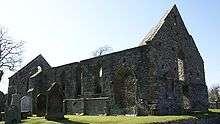 | Cathedral of St Martin of Tours and St Ninian | c. 1130 – 1690 | (Diocese of Galloway) The see of Whithorn was refounded 1128 within the English province of York (until 1472; afterwards in the Diocese/Archdiocese of Glasgow). It became a Premonstratensian cathedral priory in 1177. After 1560 parts of the 12th-century cathedral fell into disrepair. From 1690 the nave (only) became the parish kirk. In the early 18th century the main tower collapsed. In 1822 a new parish kirk was built nearby (dedicated to Saint Ninian) and much of the old monastic site was cleared for use as a burial ground. There remains, however, the roofless nave of the cathedral, and the crypt, in the care of Historic Environment Scotland. | 54.733500°N 4.417389°W |
Post-Reformation Cathedrals
During and after the Scottish Reformation (1560) cathedrals were increasingly neglected and abandoned, but episcopacy continued to be supported by Stuart Kings. By Act of the Scottish Parliament 1690 (confirming the Church's own final decision of 1689) the Church of Scotland became wholly Presbyterian, with no dioceses, no bishops, so no functioning cathedrals. At that date all Church of Scotland cathedrals became former cathedrals. Some still use the title, but for honorific purposes only.
The Scottish Episcopal Church and the Roman Catholic Church in Scotland maintain their own diocesan structures with their own cathedrals and bishops.
| Location | Image | Name | Dates | Notes | Coordinates |
|---|---|---|---|---|---|
| Edinburgh, (Midlothian), Lothian | 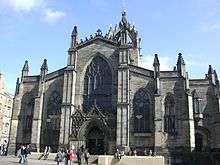
|
St Giles' Cathedral | 1633–1638 and 1661–1689 | (Diocese of Edinburgh, created 1633 from part of the Archdiocese of St Andrews) Dating from the 12th century and much enlarged over the following centuries (collegiate from 1468), St Giles' Church was elevated to cathedral status in 1633 by King Charles I for his Scottish coronation,[163] and as the seat of the Bishop of Edinburgh. When episcopacy was abolished in 1689 it became the High Kirk of Edinburgh. For a full account, see St Giles' Cathedral, Edinburgh. | 55.949524°N 3.190928°W[164] |
| Iona, Argyll and Bute |  | St Mary's Cathedral | 1630s-1638 and 1661-1689 | (Diocese of the Isles) Though an ancient place of Christian worship, started by St Columba and fellow Irish missionaries in the 7th century, it only became a cathedral for the Bishop of the Isles under Charles I following a brief period of preparation as a collegiate church. The building fell into disrepair during the 18th and 19th centuries, but was rescued and rebuilt by the Iona Community in the 20th century.[165][166] | 56.326127°N 6.400438°W |
| Location | Image | Name | Dates | Notes | Co-ordinates |
|---|---|---|---|---|---|
| Edinburgh, (Midlothian), Lothian | St Paul's Pro-Cathedral | early 19th century-1879 | Built 1816-1818, the church soon after became the Pro-Cathedral for the Episcopal Diocese of Edinburgh until 1879 when the newly-built St Mary's Cathedral was sufficiently completed. Dedicated to St Paul and St George since 1932, when the nearby church of St George closed and its congregation joined that of St Paul's. | 55.956797°N 3.188558°W | |
Post-Reformation Roman Catholic Cathedrals
| Location | Image | Name | Dates | Notes | Coordinates |
|---|---|---|---|---|---|
| Dumfries, (Dumfriesshire), Dumfries and Galloway |  | St Andrew's Cathedral | 1878–1961 | Built in 1815 and became a cathedral with the restoration of the Scottish hierarchy in 1878 for the Diocese of Galloway. On 10 May 1961, it burnt down, the cathedral was translated to Ayr and a new church was built in its place over the original crypt of the old cathedral.[167] | 55.068352°N 3.606584°W |
| Ayr, South Ayrshire | 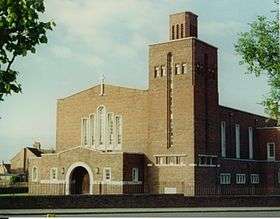 | Good Shepherd Cathedral | 1957–2007 | In 1961, after the original cathedral in Dumfries burnt down, this 1957 parish church became the cathedral of the Diocese of Galloway. Owing to falling attendance, it closed in 2007 and the see was translated to St Margaret's, Ayr.[168] In 2010, work was undertaken to convert the former church into flats. It is a category C listed building.[169] | 55.469842°N 4.599087°W |
Wales
The end of Roman rule in Britain in the early 5th century left a Romano-British (later sometimes called "Celtic") church which became increasingly confined to the western parts of the island (principally modern Wales) as Angles, Saxons, and other invaders attacked and settled from the east. This church grew in size and influence in the west during the 6th and 7th centuries (a period sometimes characterised in Wales as "The Age of the Saints")[170][171] with the conversion of ruling families (and consequently their peoples). Among the clergy the title of "bishop" was more frequently used[172] than later, when large dioceses developed. The surviving evidence for most of these early bishoprics is now fragmentary and secondary at best, if not legendary. This list contains some better-evidenced examples.
The dioceses of the Welsh church, certainly from Norman times, were, sometimes reluctantly,[173] part of the English church in the Province of Canterbury. This situation continued after the establishment of the Church of England at the Reformation until 1920, when the Church of England was disestablished in Wales, becoming the Church in Wales, a self-governing member of the Anglican Communion.
| Location | Image | Name | Dates | Notes | Coordinates |
|---|---|---|---|---|---|
| Carmarthen, Carmarthenshire | St Peter's Church | proposed | In 1536 William Barlow, newly appointed Bishop of St Davids, proposed to move the see to Carmarthen, at the time the most important town in Wales. It had just one parish church, 12th-century St Peter's, one of the largest parish churches in Wales. The Cathedral Chapter opposed the bishop, and by 1539 it had finally defeated his proposal. A similar proposal in c. 1678 by Bishop Thomas also failed.[174] The nave and chancel date from the 14th century, the tower from the 16th; the church was restored 1856-1858.[175] | 51.858001°N 4.302713°W | |
| Denbigh, Denbighshire | 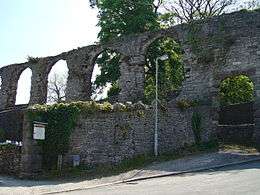 | St David's Church | proposed | Generally known as Leicester's Church, this was begun in 1578 by Robert Dudley, 1st Earl of Leicester, to supersede the nearby St Hilary's Chapel as the principal church for Denbigh (the parish church of Saint Marcella being some distance from the town). Tradition holds that St David's, planned as a large preaching hall (with a 'Gothic' exterior), was intended to replace St Asaph Cathedral, but lack of funds caused building to stop in 1584. The remaining ruin, in the care of Cadw, lies just below the walls of the (ruined) Denbigh Castle.[176] There is no access to the interior of the church. | 53.1823°N 3.4193°W |
| Glasbury, (Radnorshire), Powys | St Peter's Church | 6th century - 11th century | The village of Glasbury on the River Wye is known as the location of the 6th-century Clas Cynidr, supposedly founded by St Cynidr (otherwise Kenider). A list of bishops of Clas Cynidr survives,[177] but hardly anything remains to identify the original site of the clas or its church, which lay to the south of the modern village (on the Brecknockshire side of the river). The river changed its course in the 17th century and left the church site isolated from the village by a new stretch of river, so it was abandoned. A new church was built in the village c. 1665 but was demolished and a new one built nearby in 1838. Whatever the original dedication (St Cynidr?) the dedication of the parish church to St Peter probably dates from c. 1056 when the manor of Glasbury was granted to St Peter's Abbey, Gloucester. The co-ordinates relate to visible earthworks in a field where the clas church probably stood. | 52.04297°N 3.20246°W | |
| Holyhead, Anglesey | 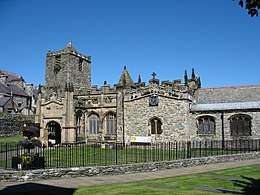 .jpg) | St Cybi's Church | 540 - 554 or later | The much-travelled Saint-bishop Cybi (English: Cubby) finally settled here c. 540, founded a large and important clas, and remained its head until his death in 554. The site became known as Caergybi, meaning Cybi's fort, and this is the Welsh name for the town of (in English) Holyhead. The 13th-century chancel is the oldest part of the parish church (shown) which stands on the ancient site.[178] The remaining nave of a 14th-century church (Eglwys y Bedd or Church of the Grave) (shown) in the south-west of the churchyard occupies the site where St Cybi may have been buried, though his shrine and relics are said to have been removed in 1405 by troops of King Henry IV, taken to Ireland,[179] and later lost at the Reformation. (Other, different, accounts exist of the origins of Eglwys y Bedd.) | 53.3114°N 4.6326°W |
| Llanbadarn Fawr, Ceredigion | 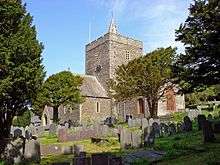 | St Padarn's Church | 6th century - ?8th century and proposed | For a comprehensive account, see St Padarn's Church, Llanbadarn Fawr. The 1920 reorganisation of the Church in Wales led to thoughts of cathedral status (owing to the great size of the Diocese of St David's), and the re-creation of a bishopric of Llanbadarn. But different arrangements ensued, so St Padarn's remains a large parish church, near Aberystwyth. | 52.409°N 4.061°W |
| Llandeilo, Carmarthenshire | 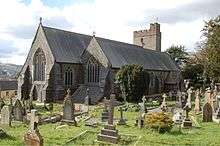 | St Teilo's Church, Llandeilo Fawr | 6th century - ?11th century | A clas was founded here, supposedly by the 6th-century abbot-bishop Saint Teilo. Several names are later recorded as bishops of Teilo, and even if some are doubtful[180] "the bishops of Teilo have impeccable 9th-century credentials".[181] Notes added to the Lichfield Gospels (here, before they were taken to Lichfield) record Bishop Nobis (or Nyfys) (872?-874). He, and Bishop Joseph (1022-1045), were both later spuriously claimed as early bishops of Llandaff.[182] Although the Llandeilo site is ancient, the double-naved church was almost totally rebuilt 1848-1850, and its 16th-century tower restored 1883.[183] | 51.88173°N 3.99285°W |
| Llanynys, Denbighshire | 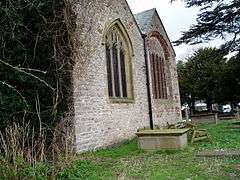  | St Saeran's Church, Llanynys | 6th century? | Tradition tells that a clas (and mother-church[184] for several villages in the area) was founded here in the 6th century. The founder is usually named as St Saeran, described as a bishop-saint, who may have come from Ireland.[185] Alternatively, St Mor has been suggested as founder, with the church being merely the burial place of St Saeran.[186] Little is known about either saint. The "generally open" church on the ancient site is double-naved: the western part of the north nave is 13th-century, the rest (apart from the 1544 porch) was built c. 1500. The stone arcade between the naves was replaced by wooden columns in 1768.[187] Among interesting features is a large mural of Saint Christopher of exceptional quality, painted c. 1415 (shown). | 53.1536°N 3.3425°W |
| Rhuddlan, Denbighshire | not known | proposed | In 1281 King Edward I and Anian II, Bishop of St Asaph, petitioned the Pope in Rome to approve the transfer of the see of St Asaph to a new, larger, fortified town being built (for English settlers) at Rhuddlan, due to claimed remoteness and dangers of St Asaph itself. But a Welsh rising in 1282 and further territorial gains by the English led to the proposal's abandonment by 1283. The intended site of the cathedral in Rhuddlan was probably used for the construction of the new parish church, St Mary's, in c.1300 (shown).[188] | 53.2907°N 3.4696°W | |
| St Asaph, Denbighshire | Church of St Kentigern and St Asa | 6th century - ?11th century | According to his hagiographer,[189] a clas was founded by St Kentigern in c. 560 at Llanelwy ("sacred enclosure on the River Elwy"). After his return to the Glasgow area Kentigern was succeeded here as bishop by Saint Asaph (or Asaf, or Asa), which later led to Llanelwy being known (in English) as St Asaph. The site of the original (wooden) cathedral is almost certainly now occupied by the parish church (near the river) at the foot of the hill crowned by the current cathedral, originally Norman following the re-establishment of the bishopric in 1143.[190] The double-naved parish church building (shown) dates from the 13th century and later. | 53.25705°N 3.44525°W | |
The Seven Bishop-Houses of the Kingdom of Dyfed[191][192][193][194][195]
Collections of medieval Welsh Law[191] record that the (early medieval) Kingdom of Dyfed had seven so-called "bishop-houses" (in Welsh esgopty), following a general pattern of one bishop-house in each cantref.[196] Their role is not clear, but they must have been relatively important ecclesiastical sites (with St Davids having a higher status than any of the others). Apart from the Bishop of St Davids, their heads were described as abbots, not bishops. Whether the other six were also bishoprics, former bishoprics, burial places of saint-bishops,[197] or staging posts in the travels of (say) the bishop of St Davids[198] is debated. They are included in this List of former cathedrals in Great Britain on the basis that any and all of them may well have been the seat of a bishop at some time. Details of all seven bishop-houses are given below for the sake of completeness, although St Davids has never ceased to be the seat of a bishop. The status of bishop-house, as distinct from the cathedral at St Davids, seems not to have survived the ending of the Kingdom of Dyfed (920), even less the arrival of the Normans.
It should not be assumed that the sites identified below are exactly the original sites of the bishop-houses (with the probable exception of Llandeilo Llwydarth): some minor relocation over the course of centuries cannot be ruled out.
| Location | Image | Medieval Placename (spellings may vary) | Pre-Norman Cantref (spellings may vary) | Notes | Coordinates |
|---|---|---|---|---|---|
| St Davids, Pembrokeshire | 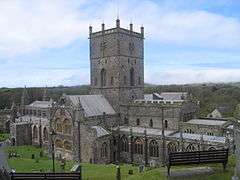 | Mynyw | Prebidiog | The cathedral at St Davids is not a former cathedral: to the contrary, it has continued to be the seat of a bishop since its foundation in the 6th century. It only appears here to complete this sub-list of Dyfed's seven bishop-houses. For more details see St Davids Cathedral. | 55.469842°N 4.599087°W |
| Carmarthen, Carmarthenshire | Llan Teulydawc | Gwarthaf | The Normans made the church a cell of Battle Abbey. Later, in c.1125, the Bishop of St Davids founded here the Priory of St John the Evangelist and St Teulyddog with Augustinian Canons (dissolved 1536). Eventually the site was cleared c.1781 and put to industrial use. A late medieval gatehouse survives, subdivided for residential use. | 51.860149°N 4.296345°W | |
| Clydau, Pembrokeshire |  | Llan Geneu | Emlyn | The 14th-15th century parish church (shown) is dedicated to St Clydai but the medieval placename clearly refers to St Ceneu. Restored in the late 19th century, the most original parts of the church are its tower and nave. It is sited centrally among the five hamlets it serves. | 51.99°N 4.5488°W |
| Llandeilo Llwydarth, Maenclochog, Pembrokeshire | Llan Teilaw | Deugleddyf (originally) | A minor pre-Norman boundary adjustment led to the church "moving" to Cantref Cemais.[199] Dedicated to Saint Teilo, it was abandoned sometime after 1833. The ruin lies in a circular enclosure, with St Teilo's Well some 150m to the north-east. The water had reputed healing powers, notably when drunk from the saint's supposed skull (now kept in the south chapel of Llandaff Cathedral). | 51.908215°N 4.764448°W | |
| Rhoscrowther, Pembrokeshire | .jpg) | Llan Degeman | Penfro | St Decuman's church is now largely isolated by an oil refinery to its immediate north, and an army gunnery range to the south. The village was evacuated in 1994 after a refinery explosion. The church is 14th century (the nave and chancel possibly older), restored in the 19th century,and now cared for by Friends of Friendless Churches. | 51.6794°N 5.0332°W |
| Saundersfoot, Pembrokeshire | .jpg) | Llan Ussyllt | Penfro | The town of Saundersfoot lies within the ancient parish called St Issells by the Normans. The parish church, dedicated to Saint Issel, stands about 0.5 miles (1 km) north of the town. Its chancel arch is 13th century and the tower is 14th/15th century. It was restored 1862-64. | 51.7199°N 4.705°W |
| St Ishmaels, Pembrokeshire | 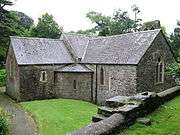 | Llan Ismael | Rhos | The original church here was "the home of St Ishmael, who became the second bishop of St Davids in c.589".[200] The oldest parts of the present church (shown) may be 12th century. It is about 0.5 miles (0.9 km) south of the rather isolated village of St Ishmaels, in an area called Monk Haven, with some early monastic remains nearby. | 51.7173°N 5.1426°W |
Notes
- here defined as a member church of the World Council of Churches or the (Roman) Catholic Church
- but not one designated as an area bishop, an assistant bishop, or a suffragan bishop
- Cook, David (2004). St Boniface 675/754 - the first European. Crediton: Crediton Church Corporation, p. 15
- Jeffery (2012), p. 23
- Smith (2011), p. 117
- The fort of Othona and the chapel of St. Peter-on-the-Wall Bradwell-on-Sea Essex (Booklet available at the Chapel itself)
- Brabbs (1985), p. 23
- Jeffery (2012), pp. 22-23
- Tatton-Brown (1989), pp. 21-22
- Taylor, M. I. The Cradle of English Christianity (St Martin's and St Paul's PCC, Canterbury, 1997)
- Fryde (1986), p. 222
- not a "Bishop of Cornwall"; the extent of his influence is unknown
- an indication of the growing extent of Anglo-Saxon influence on Cornwall
- which could mean a some sort of collegiate church or a monastery
- Olson (1989), pp. 51-56; Jankulak (2000), pp. 57-60
- Olson (1989), p. 54
- Jones, T. The English Saints: East Anglia (Canterbury Press, Norwich, 1999), p.57
- Tiller (2005), pp. 25-26
- Kirby, D. P. The Saxon Bishops of Leicester, Lindsey (Syddensis), and Dorchester in Trans. Leics. Arch. & Hist. Soc., Vol. 41 (1965-66), p. 2
- Tiller (2005), pp. 41-42
- Jenkins (1999), p. 542
- Cannon (2011), p. 313
- Jeffery (2012), p. 18
- Cannon (2011), p. 314
- Crook, J. (2000) The Architectural Setting of the Cult of Saints in the Early Christian West c. 300 - 1200 Oxford: Oxford University Press, pp. 167-169
- Jeffery (2012), p. 103
- Orme (2014), pp. 7-9, 81-82
- Orme (2014), pp. 7-9, 133-134
- Jeffery (2012), p. 31.
- Priory of Hoxne from British History Online retrieved 3 June 2013
- Kirby, D. P. The Saxon Bishops of Leicester from University of Leicester retrieved 18 May 2013
- Midmer (1979), p. 201
- Tatton-Brown (1979), pp. 24, 26, 48
- Olson (1989), pp.66-67
- Godfrey (1962), p.53
- British History Online retrieved 18 May 2013
- Hill (1900), p. 82
- Fryde (1986), p. 220
- Jeffery (2012), p. 20
- Midmer (1979), p. 262
- though Conan was probably an assistant/suffragan to the bishop of Crediton: see Finberg, H. P. R., "Sherborne, Glastonbury, and the expansion of Wessex" in Transactions of the Royal Historical Society, 5th series, 3 (1953), pp. 118-19
- "[A]bout a mile east of the present church" according to Bright (1897), p. 346, where exactly one mile east of Selsey's parish church of St Peter (built 1864-66) would mean one-eighth of a mile off the coast just south of Selsey's Inner Owers sandbank; but, according to a map on Historic England's PastScape website on <Selsey Cathedral> (drawing on the National Record of the Historic Environment) the cathedral's site is about 350 meters off the coast and 700 meters west of the (southern) tip of the promontory known as Selsey Bill. See also Godfrey (1962), p. 140.
- Jeffery (2012), pp. 42-43.
- Julian Munby. Saxon Chichester and its Predecessors in Haslam. Anglo-Saxon Towns in Southern England. pp. 317–320
- Tatton-Brown. The Medieval Fabric in Hobbs. Chichester Cathedral: An Historic Survey. p. 25
- Kelly. The Bishopric of Selsey in Hobbs. Chichester Cathedral: An Historic Survey. pp. 1–10.
- St Andrew's Church from Soham.org retrieved 18 May 2013
- Hadcock, R.Neville; Knowles, David (1971). Medieval Religious Houses England & Wales. Longman. p. 482. ISBN 0-582-11230-3.
- GENUKI. Stow-in-Lindsey. Retrieved on 15 June 2007
- Chanter, J.R. Tawton: The First Saxon Bishopric of Devonshire, Report and Transactions of the Devonshire Association for the Advancement of Science, Literature and Art, Vol. VII (1875), pp. 179-196.
- reported by Pedler (1896), p. 4 n. 1, citing "Camden and Bishop Godwine"
- Cutts (1887), p.278.
- Orme, N. The Church in Devon: 400-1560 (Exeter, 2013), caption to Fig. 9
- Tatton-Brown (1989), p. 43.
- Cannon (2007), p. 431
- Davies (1978), p. 75
- Williams (1962), p. 89
- Bowen (1956), pp. 36-37
- Davies (1979), p. 92-93
- but Coplestone-Crow (2009), p. 105 locates the original site (no remains) 3 km to the south-west at Hentland, in the adjoining parish of Goodrich on the eastern bank of the River Wye just west of the most southerly western border of Welsh Bicknor parish. On this question, see also Ray, K. "Archaeology and The Three Early Churches of Herefordshire" in Malpas, Ann et al (eds.). "The Early Church in Herefordshire". (Leominster: Leominster History Study Group). 2001. ISBN 0 9536314 1 9., pp. 116, 118
- Home | Bath Abbey
- Jeffery (2012), pp. 53-55
- Jeffery (2004), pp. 112-115
- Midmer (1979), p.119
- Cannon, J. Cathedral. London: Constable & Robinson. 2007, pp. 301-303.
- Demidowicz, George (ed) (1994) Coventry's First Cathedral (Stamford: Paul Watkins Publishing) ISBN 1-871615-49-6
- Carley, James P., 'Glastonbury Abbey', Gothic Image Publications (Glastonbury, 1996), pp. 2-5.
- Jeffery (2012), pp. 58-59.
- Rahtz, Philip, 'Glastonbury', B.T. Batsford Ltd. / English Heritage (London, 1993), p. 66.
- Jeffery (2012), pp. 63-64.
- Jeffery (2012), pp. 64-65
- Jeffery (2004), pp. 175-178
- Jeffery (2012), p. 71
- Jeffery (2012), p. 80
- Smith (2011), pp. 143-144
- Smith (2011), pp. 312-315
- Jeffery (2012), p. 70
- Jeffery (2012), pp. 77-80
- Holy Trinity Church, Guildford, Surrey History Archived 2013-05-11 at the Wayback Machine retrieved 18 May 2013
- Jeffery (2012), pp. 81-82
- Jeffery (2012), pp. 83-84
- Guide Book "The Church of St Mary the Virgin" published 2016? by Jarrold Publishing, Peterborough ISBN 978-0-85101-593-4, p.15., gives 1890 as the date of the chair's installation, despite Southwell Minster having been preferred in 1884.
- Jeffery (2012), p. 74
- Jeffery (2012), pp. 86-88
- Sir Walter Tapper & his Churches :: St Erkenwald's Church, Southend-on-Sea ::
- Smith (2011), p. 123
- Waltham Archived 2010-01-13 at the Wayback Machine from Britannia.com retrieved 20 May 2013
- Jeffery (2012), p.71
- Jeffery (2012), p. 92.
- Archdiocese of Westminster from NewAdvent.org, retrieved 19 December 2014
- Silver Jubilee of the Diocese of Menevia, Rt Rev Paul Stonham, Abbot of Belmont's Homily from Catholic Bishops' Conference of England and Wales retrieved 3 April 2014
- Home Page
- Library from CatholicCulture.org retrieved 16 May 2013
- Church Gazetteer from St Nicholas Centre retrieved 22 April 2013
- Moseley, Brian (11 June 2011). "Church of Saint Mary". The Encyclopaedia of Plymouth History. Archived from the original on 5 October 2013. Retrieved 13 February 2015.
- History of the Portsmouth Diocese Archived 2014-04-16 at the Wayback Machine from the Catholic Association retrieved 28 March 2014
- "The Full History of St George's Church". St George's Catholic Church, York. Archived from the original on 28 August 2011. Retrieved 14 August 2011.
- "Church History". St. Wilfrid's Catholic Church in York. Archived from the original on 28 September 2011. Retrieved 14 August 2011.
- by a 1542 Act of Parliament
- Gelling (1998), p. 2
- Gelling (1998), p. 41
- Coakley, Frances (2007), The Ruined Cathedral of St. German, Peel, Isle of Man, A Manx Note Book: An Electronic Compendium of Matters Past and Present Connected with the Isle of Man, retrieved 16 August 2009.
- such as the Celtic origin of early bishoprics, the difficult topography, the social structure
- Bede "A History of the English Church and People" IV.12.
- Bede "A History of the English Church and People" IV.26.
- Smith (2011), p.525
- Abercorn History Archived 2014-04-08 at the Wayback Machine retrieved 24 May 2013
- Building History from St Machar's retrieved 24 May 2013
- Fryde (1986) p.303
- Fawcett (1997), p.112
- Abernethy Village Archived 2013-07-23 at the Wayback Machine retrieved 24 May 2013
- Fryde (1986) p.316
- History Archived 2013-07-24 at the Wayback Machine from Birnie.org retrieved 21 May 2013
- Smith (2011), p. 514.
- Lamb, R G "The Cathedral of Christchurch and the Monastery of Birsay" Procs. of Soc. of Antiquaries of Scotland (1972-4), pp.200-205
- Salter (2011), p. 48.
- Crawford, Barbara, 'The Earldom of Caithness and the Kingdom of Scotland, 1150-1266' in Keith Stringer (ed.), Essays on the Nobility of Medieval Scotland, (Edinburgh, 1985), pp. 25-43
- the spelling of St Blaan (otherwise Blane) is from Listed Buildings records held by Historic Scotland
- Fawcett (1997), p. 113.
- Salter (2011), p. 54.
- History Archived 2013-02-17 at the Wayback Machine from Dunblane Cathedral retrieved 21 May 2013
- Fawcett (1997), p.113
- Fawcett (1997), p.24
- Orkneyinga Saga, 48
- Fawcett (1997), p. 114.
- Historic Scotland retrieved 24 May 2013
- Fryde (1986), p. 311.
- Shead, N.F. (1969) The Origins of the Medieval Diocese of Glasgow in Scot. Hist. Rev. (48), pp. 220-225.
- OPS (1855), Vol.2, p.756
- Dowden (1912), pp.233-234
- OPS (1855), Vol.2, p.757
- Fawcett (1997), p.15
- Parker, M. (2012) An Eighth-Century Reference to the Monastery at Hoddom in Jnl. of Scottish Name Studies (6), 51-80.
- Kingarth in Historic Scotland retrieved 24 May 2013
- Keith, Robert, An Historical Catalogue of the Scottish Bishops: Down to the Year 1688, (London, 1924)
- Pennant, T. "A Tour in Scotland 1769" (London, 1790), p.297
- Fawcett (1997), p.116
- Jesch, J. & Molleson, T. "The Death of Magnus Erlendsson and the Relics of St Magnus" in Owen, O. (ed) The World of the Orkneyinga Saga, Orkney Islands Council, 2006, pp.127-144
- Fawcett (1997), p. 116.
- Ewart, G. 'Inchaffray Abbey, Perth and Kinross: excavation and research, 1987' in Proc. Soc. Antiq. Scot., 126 (1996) p. 472
- Fawcett (1997), p.47
- Ewart, G. 'Inchaffray Abbey, Perth and Kinross: excavation and research, 1987' in Proc. Soc. Antiq. Scot., 126 (1996) p. 478
- Alex Woolf,Cult of Moluag from University of St Andrews, retrieved 3 December 2014
- Fawcett (1997), p. 116
- Scottish Places retrieved 24 May 2013
- Fawcett (1997) pp. 17–19
- Fawcett (1997), p.117.
- Godfrey (1962) p.258
- Smith (2011), p. 497.
- though Fawcett (1997), p.19. thinks up to 50 years later
- Fryde (1986) p.320
- Fawcett (1997), p. 117.
- OPS (1865), Vol.2, p.756
- Dowling (1912), pp.233-234
- Pennant, T. "A Tour in Scotland 1769" (London, 1790) p. 297
- Slade & Watson (1989), p. 300
- Historic Environment Scotland. "Thurso, St Peter's Church and Burial Ground (SM618)". Retrieved 1 April 2019.
- Slade & Watson (1989), p. 310
- Slade & Watson (1989), p. 318
- Chadwick (1961), p. 134
- Fryde et al. (1986), pp.222-223.
- http://www.aboutscotland.com/whithorn/priory.html
- Fawcett (1997), p. 113
- A M Mackenzie, Scottish Pageant 1625-1707, (Oliver & Boyd, 1949), pp.102-03
- Herbermann, Charles, ed. (1913). 'Diocese of Argyll and the Isles'. Catholic Encyclopedia. Robert Appleton Company.
- Fawcett (1997), p. 115.
- "History Archived 2014-03-27 at the Wayback Machine" from St Andrew's Church, Dumfries, retrieved 2 December 2014
- "Good Shepherd Cathedral, Ayr" from Open Buildings, retrieved 2 December 2014
- "A cathedral transformed" from Ayrshire Housing, retrieved 2 December 2014
- Chadwick (1961), esp pp. 3-5
- Williams (1962), p. 88
- "Probably in these early centuries almost every church had its own bishop" (Edwards (1912), p. 47)
- M. Richter (1971). Canterbury's Primacy in Wales and the first stage of Bishop Bernard's Opposition in Jnl of Eccles. Hist., 22, pp. 177-189.
- Williams, G. The crisis of the sixteenth century in Evans (2007), pp. 330-338
- Wooding (2011), pp. 170-171
- Denbigh Castle and Town Walls: Lord Leicester's Church, St Hilary's Chapel, Denbigh Friary (CADW Guidebook)
- Davies (2007), "The Archbishopric of St Davids and the bishops of Clas Cynidr" in Evans (2007), pp. 300-301
- Wooding (2011), p. 91
- Smith (2011), p. 396
- Fryde (1985), p. 289
- Davies (2003), p. 16
- Davies 2003, pp. 9-31, 148. The Book of Llandaff (the basis of that claim, and others) uses dubious evidence to lend spurious antiquity to the origins of the 12th-century Diocese of Llandaff and bolster its territorial claims against the ancient Diocese of St David's (in which Llandeilo lies) and the (English) Diocese of Hereford.
- Wooding (2011), p. 178
- Bowen (1956), pp. 115-117
- Bowen (1956), p. 97
- Thomas, D. R. (1874) A History of the Diocese of St. Asaph London: James Parker & Co. Vol 1, p. 436
- Wooding (2011), p. 66
- Taylor, A. J. (1954-55) Rhuddlan Cathedral: 'a might-have-been' of Flintshire history in Flintshire Historical Society Transactions, Vol. 15, pp. 43-51
- Life of Kentigern by Jocelyn of Furness (written c. 1180), Ch. xxiv
- Davies (1982), p. 159
- Charles-Edwards (1971)
- Charles-Edwards (2013), pp.596-598
- Davies (1982), pp.158-160
- James (2007), pp.47-68
- Petts (2009), pp.162-164
- Charles-Edwards (2013), p. 597
- Charles-Edwards (2013), p.597
- Charles-Edwards (2013), p.598
- James (2007), p.57
- Smith (2011), p.450
References
- Barlow, Frank (2nd edn. 1979). The English Church 1000–1066. London: Longman. ISBN 0-582-49049-9.
- Barrell, Andrew D. M. (2000). Medieval Scotland. Cambridge: Cambridge University Press. ISBN 978-0-521-58443-2.
- Blair, John (2005). The Church in Anglo-Saxon Society. Oxford: Oxford University Press. ISBN 0-19-822695-0
- Bowen, E. G. (2nd edn. 1956). The Settlements of the Celtic Saints in Wales. Cardiff: University of Wales Press.
- Brabbs, Derry (1985). English Country Churches. London: George Weidenfeld & Nicolson.
- Bright, William (1897). Chapters of Early English Church History. Oxford: Clarendon Press.
- Cannon, Jon (2007). Cathedral. London: Constable & Robinson. ISBN 978-1-84901-679-7
- Chadwick, Nora K. (1961). The Age of the Saints in the Early Celtic Church. London: Oxford University Press.
- Charles-Edwards, T. M. (1971). "The Seven Bishop-Houses of Dyfed" in Bulletin of the Board of Celtic Studies (University of Wales), 24, 1970-2, 247-62.
- Charles-Edwards, T. M. (2013). Wales and the Britons 350-1064. Oxford: Oxford University Press. ISBN 978-0-19-821731-2
- Coplestone-Crow, Bruce (2009). Herefordshire Place-names. Almeley, Herefordshire: Logaston Press. ISBN 978-1906663-21-6
- Cutts, Rev. Edward L. (1887). A Dictionary of the Church of England. London: Society for Promoting Christian Knowledge.
- Davies, John Reuben (2003). The Book of Llandaf and the Norman Church in Wales. Woodbridge: Boydell Press. ISBN 1-84383-024-8.
- Davies, Wendy (1978). An Early Welsh Microcosm: Studies in the Llandaff Charters. London: Royal Historical Society. ISBN 0-901050-33-4.
- Davies, Wendy (1979). The Llandaff Charters. Aberystwyth: The National Library of Wales. ISBN 0-901833-88-6.
- Davies, Wendy (1982). Wales in the Early Middle Ages. Leicester: Leicester University Press. ISBN 0-7185-1163-8.
- Dowden, John (1912). The Bishops of Scotland, ed. J. Maitland Thomson: Glasgow.
- Edwards, David L. (1989). The Cathedrals of Britain. Norwich: Pitkin Pictorials.
- Evans, J. Wyn & Wooding, Jonathan M. (eds.). (2007). St David of Wales: Cult, Church and Nation. Woodbridge: Boydell Press.. ISBN 1843833220.
- Fawcett, Richard (1997). Scottish Cathedrals. London: B. T. Batsford / Historic Scotland ISBN 0-7134-8188-9.
- Fryde, E. B., Greenway, D. E., Porter, S. & Roy, L. (eds) (3rd edn. 1986). Handbook of British Chronology. London: Royal Historical Society. ISBN 0-86193-106-8.
- Galloway, Peter (2000). The Cathedrals of Scotland. Dalkeith: Scottish Cultural Press ISBN 1-84017-026-3.
- Gelling, (Canon) John (1998). A History of the Manx Church 1698-1911. Douglas: The Manx Heritage Foundation. ISBN 0-952-4019-4-0.
- Godfrey, C. John (1962). The Church in Anglo-Saxon England. Cambridge: Cambridge University Press
- Green, Lionel 2002). Daughter Houses of Merton Priory. Morden: Merton Historical Society ISBN 1-903899-08-7.
- Haslam, Jeremy, ed. (1984). Anglo-Saxon Towns in Southern England. Chichester, Sussex: Philimore. ISBN 0-8503-3438-1.
- Hill, Geoffrey (1900). English Dioceses. London: Elliot Stock.
- Hobbs, Mary, ed. (1994). Chichester Cathedral: An Historic Survey. Chichester: Phillimore. ISBN 0-85033-924-3.
- James, Heather (2007). "The geography of the cult of St David: a study of dedication patterns in the medieval diocese" in Evans & Wooding (2007), pp. 41–83
- Jankulak, Karen (2000). The Medieval Cult of St Petroc. Woodbridge: The Boydell Press ISBN 0-85115-7777.
- Jeffery, Paul (2004). The Collegiate Churches of England and Wales. London: Robert Hale ISBN 0-7090-7412-3.
- Jeffery, Paul (2012). England's Other Cathedrals. Port Stroud: The History Press ISBN 978-0-7524-5347-7.
- Jenkins, Simon (1999). England's Thousand Best Churches. Harmondsworth: Allen Lane The Penguin Press ISBN 0-713-99281-6.
- Knowles, David & Hadcock, R. Neville (1971, 2nd edn.). Religious Houses England & Wales. London: Longman. ISBN 0-582-11230-3.
- Midmer, Roy (1979). English Mediaeval Monasteries 1066-1540. London: William Heinemann.
- New, Anthony S. B. (1972). The Observer's Book of Cathedrals. London: Frederick Warne & Co.
- Olson, Lynette (1989). Early Monasteries in Cornwall. Woodbridge: Boydell Press ISBN 0-85115-478-6.
- OPS (1865) Origines Parochiales Scotiae. Edinburgh: W. H. Lizars.
- Orme, Nicholas (2007). Cornwall and the Cross. Chichester: Phillimore & Co. ISBN 978-1-86077-468-3.
- Orme, Nicholas (2014). The Churches of Medieval Exeter. Exeter: Impress Books. ISBN 978-1-907605-51-2.
- Pedler, Edward Hoblyn (1856). The Anglo-Saxon Episcopate of Cornwall; with some account of the Bishops of Crediton. London: John Petheram.
- Pepin, David (1994). Discovering Cathedrals. Aylesbury: Shire Publications.
- Petts, David (2009). The Early Medieval Church in Wales. Stroud: The History Press. ISBN 978-0-7524-4102-3.
- Platten, Stephen (1999). Cathedrals & Abbeys of England. Norwich: Jarrold.
- Salter, Mike (2011). Medieval Abbeys and Cathedrals of Scotland. Malvern: Folly Publications ISBN 978-1-871731-89-7.
- Slade, H. Gordon & Watson, George (1989). St Peter's Kirk, Thurso, Caithness c 1150-1832 in Proceedings of the Society of Antiquaries of Scotland Vol. 119, pp. 297–325.
- Smith, Nick Mayhew (2011). Britain's holiest places. Bristol: Lifestyle Press Ltd. ISBN 978-0-9544767-4-8.
- Tatton-Brown, Tim (1989). Great Cathedrals of Britain. London: BBC Books. ISBN 0-563-20730-2.
- Thorold, Henry (1986). Collins Guide To Cathedrals, Abbeys and Priories of England and Wales. London: Collins.
- Tiller, Kate (ed) (2005). Dorchester Abbey: Church and People 635-2005. Witney: Stonesfield Press ISBN 0-9527126-4-4.
- Williams, A. H. (1962). An Introduction to the History of Wales: Volume 1 - Prehistoric Times to 1063 AD. Cardiff: University of Wales Press.
- Wooding, Jonathan M. & Yates, Nigel (eds) (2011). A Guide to the Churches and Chapels of Wales. Cardiff: University of Wales Press. ISBN 978-0-7083-2118-8.
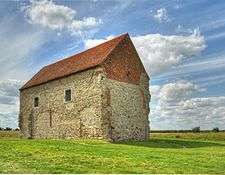



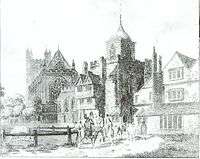
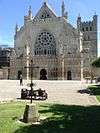
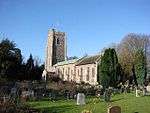

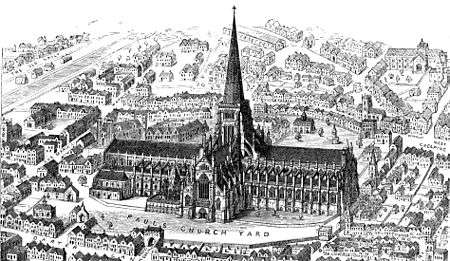
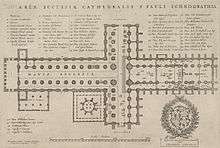
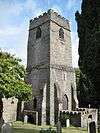
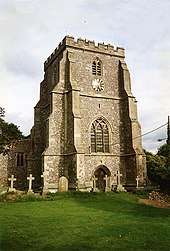

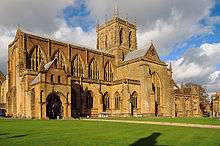
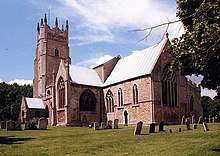
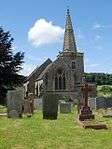
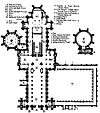
_(geograph_3637265).jpg)
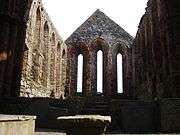
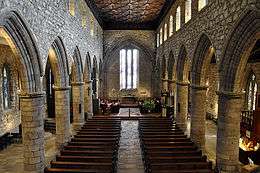
.jpg)



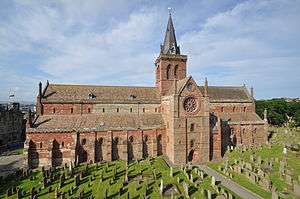



.jpg)
